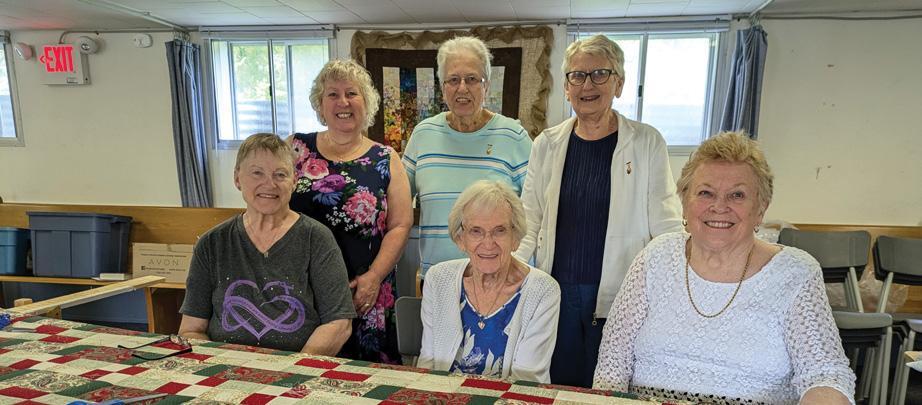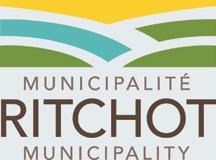n















HSD Takes Action
n
Details

















n















n
Details
















By Sara Beth Dacombe m sdacombe@nivervillecitizen.com
A Maze in Corn, an outdoor amusement centre north of St. Adolphe, has been involved in an ongoing legal tussle with the provincial government over its operation of the Red River Floodway.
The flooding occurred upstream of Winnipeg when the province decided to close the floodgates to prevent sewer backup in the city in the fall of 2019 when Manitoba received a record amount of rainfall.
That decision resulted in damage to A Maze in Corn’s parking area and Haunted Forest during peak season for the Halloween-themed attraction.
According to business owner Clint Masse, the damage was estimated at $300,000 by the province’s own insurance adjustor.

The province denied this amount, however, and instead offered a payout of just $70,000.
Masse appealed to the provincial governing body in 2020 and was awarded an adjusted increase, raising the amount of compensation to $181,559.
Masse decided he couldn’t accept that and, having exhausted his appeal channels, made a legal claim against the province.
That case was heard in court on January 17, 2023. By the fall, the judge had decided in Masse’s favour.
However, Masse continues to wait for payment. While his argument won in court, the onus is once again on the province to adjust the amount—at their own discretion.
Masse, who has farmed the property for most of his life, says something isn’t right about how the decisions were made at the


provincial level that resulted in the loss of income for his business. He wants others in the Red River floodplain upstream of Winnipeg to know more about their rights when the province operates the Floodway.
When waters were rising in the fall of 2019, Masse was concerned… but not that the water would threaten his business. His land is located at the corner where the Seine River Diversion meets Highway 200 and then enters the Red River.
What did concern Masse was talk of the government operating the Floodway during autumn for the first time in its history.
Masse called the province to see about the likelihood of this and was told it wasn’t happening.
(continued on page 4)






(continued from page 3)
The next day, a neighbour called him to say that the floodgates were operating. By that evening, Masse’s parking lot and the Haunted Forest were underwater.
“Nobody wants a flood,” says Masse. “Nobody wants to clean up after a flood. The fact that we have a Haunted Forest, down in a ravine… it’s creepy. It’s a great place to be. For sure, it’s a low area. But no one expected it to flood that year.”
Masse notes that there was no public opposition at the municipal level when he first set out to open a business on his farmland. He knew it was risky to build an attraction on land that was desirable yet low.
He has looked for ways to position each attraction wisely, or to acquire flood protection.
“If I could move [the Haunted Forest], and we are talking about moving it to our back forest, if we could get flood protection we would,” he says. “But can you qualify for flood insurance for a forest? It’s not easily done.”
Masse says the Haunted Forest is the crux of his business in the fall.
After use of the Floodway damaged his property, he watched the weather and waited, taking stock of what had happened. Most property owners living south of Winnipeg know that their properties will be sacrificed to save Winnipeg, even though it hurts when it has to happen.
As he waited, though, he suspected that in this case it did not have to happen.
“In hindsight, they never needed to raise the gates. They made a bad call,” says Masse. “There was risk. They analyze costs and damages. [Their report] said to expect $300,000 of losses south of Winnipeg and $100,000 in cost to operate the gates. So a total cost of $400,000 and the total benefit to Winnipeg would be $2.2 million… But they never got the rain that season to fulfill the forecast. There was no big deal. It was high, yes. It was for sure high. And they made the decision to store water here to save basements in Winnipeg that never would have flooded.”
Masse says that he isn’t unrealistic about what needs to be done to save the city from a natural flood. That is the function of the Floodway.
But the fact that the projected rainfall didn’t come and waters wouldn’t have continued to rise makes the situation emotionally charged.
Emotions aside, Masse says he just
wants his income reimbursed, as he is owed under the provisions of The Red River Floodway Act.
“There’s all kinds of rules and regulations as to how to operate the floodgates,” he says. “They’re not meant to be operated out of season. The spring season is when they’re supposed to operate them. In addition to these set of rules, when [the province is] settling with a business directly affected by floodwaters, the Emergency Measures Organization says by law they have to hire an accredited business loss adjuster. They have to. It’s in the Act.”
But what’s not in the Act is a provision forcing the government to use their own insurance adjuster’s evaluation.
To aid the adjuster sent by the province after the 2019 flooding, Masse provided five years of income statements and suggested a five-year average as adequate compensation.
“The business loss representative said, ‘That works. That’s a good number.’ And we were willing to accept that. But then the province essentially said, ‘We’ll give you 30 cents on the dollar,’” says Masse. “But we were like, ‘It doesn’t say that in the Act. It says you cover all losses.’”
After exhausting the appeal process, Masse said he was left with no choice but to hire his own lawyer and pursue legal action. That process took more than a year.
bill.’ It’s a motivation to come to an agreement quicker.”
With the ball back in the province’s court, the Masses are tired, but they aren’t ready to give up.
They say that if the province doesn’t come back to them with a reasonable figure, they will pursue a legal remedy a second time.
“I think if we fail again, we are going through the process again. We could conceivably appear in front of the court again.”
Most homeowners and business operators from Howden to Ste. Agathe know they live and work on a floodplain.
But most don’t pay attention to the criteria the province must follow to operate the Floodway gates.
Masse says that more property owners along the river need to make themselves aware of the criteria.
and examples of when the Floodway has been operated outside of spring.
According to that factsheet: “Artificial flooding of some land and roads south of the floodway inlet control structure occurs when water levels out of the floodway channel inlet are raised above natural… In these instances, the Manitoba government provides compensation to individuals who experienced physical damages due to artificial flooding.”
Though written before 2019, the factsheet also states: “In all years of post spring operation… compensation was provided to affected residents for tangible damages (ex: damages to agricultural crops, roads, backyards and gardens).”
The provincial government has spent considerable time reviewing the Floodway and its operations on behalf of both public and private interests.
“In hindsight, they never needed to raise the gates. They made a bad call… They made the decision to store water here to save basements in Winnipeg that never would have flooded. ”
Clint Masse | Owner, A Maze in Corn
While the result came down in his favour, it didn’t turn out as expected.
“The court of King’s Bench hears us based on err of law. So they rule on whether an error has been made, which they found there was. Then they decree the other party has to remedy that,” says Masse. “But they don’t do dollar amounts.”
In a situation like this, it means that the Masses are now entitled to appeal the matter again, and the province has to go back through its evaluation process to come up with a more reasonable figure.
“They did such a poor job with the assessment before, and we’re going to do this all over again? It doesn’t make a lot of sense,” says Masse. “The judge agreed with that. [The judge] said, ‘[The province] is liable for your legal fees going backward and all legal feels going forward.’ They structured that as the remedy they can apply. ‘If [the government] keeps fighting with you, they’re going to keep paying your
“What I’m finding is the people who work [in government], the people I worked with directly, they don’t know the Floodway Act either,” he says. “They’re telling you what is and what isn’t covered, making judgments and rulings on things, and they don’t even know the Act. The frontline people don’t know the Act, that it says they have to supply compensation for artificial flooding… I don’t think they had any clue what was required of them. It was on me to know.”
Masse says that The Red River Floodway Act is available online and is a pretty concise read.
Manitoba Infrastructure also provides information on Flood Control Infrastructure and defines the four guidelines under which the Floodway would be operated.
Another tool provided online is a factsheet on the Post-Spring Non-Emergency Operation of the Red River Floodway, which provides helpful illustrations about how the Floodway works, along with dates
Of interest are the mounting arguments in support of increasing the frequency of operating the Floodway beyond the scope of spring flooding, which would enable water levels in Winnipeg to regulate more predictably, creating both recreational and commercial opportunities.
To allow for the increased operation of the Floodway, according to the report, the province would be required to “undertake a variety of physical works, and upgrades to existing works, estimated to have a one-time cost of $55 million to $80 million. The increased floodway operating costs are estimated at up to $300,000 annually.”
The province would also need to compensate landowners for any damages caused by artificial flooding, as per the provisions of The Red River Floodway Act.
Non-emergency operation which increases artificial flooding upstream of the Floodway was studied in 2015 through multiple public focus groups and roundtable discussions, resulting in the Provincial Flood Control Infrastructure report.
Not surprisingly, it is well documented that residents upstream of the Floodway have a history of mistrust of the provincial government, and specifically the Manitoba Floodway Authority.
The Floodway was operated outside of spring four times prior to 2015. Applicants who were artificially flooded received compensation of
$308,976 (among 21 applicants in 2002), $366,158 (among 61 applicants in 2004), $1,114,930 (among 120 applicants in 2005), and $76,017 (among 24 applicants in 2010).
In contrast to these figures, the most recent study into the question of whether to use the Floodway to reduce basement flooding in Winnipeg was conducted in 2013.
It showed a benefit of $800,000 per year in reduced damages.
However, the study indicated that for any individual storm event, the benefits for the city and province could be in the tens of millions.
As Masse sees it, there is no doubt that the Red River Floodway is a good solution to a very difficult problem.
“It is a very flat plain that we live on and, yes, we need to manage the crazy amount of drainage the farmers are doing and keep the City of Winnipeg alive,” says Masse. “It’s a monster tool. The problem with a monster tool is there can be kind of a nuclear fallout.”
The environmental license for the Floodway stipulates a public review of the rules of operation not less than once every five years. As discussions surrounding the use of the Floodway continue, Masse would like to see more community members south of the city make themselves aware of the matter and participate more actively in future talks.
“They’re changing the Red River Floodway Act and I’m going to champion some watchdogging,” says Masse. “I’m hoping I’m doing some work for some guy who has not been squared up with… Our company is a little bit bigger and if you’re a small market partner you won’t be able to [afford a legal battle] and you just have to roll over. If the province had followed the rules, they would’ve saved money… saved taxpayers money.”
The province did not respond to requests for comment to this story.
n The Red River Floodway Act: https:// web2.gov.mb.ca/bills/38-2/b023e.php
n Manitoba Infrastructure Hydrologic Operations: https://www.gov.mb.ca/mti/wms/ops/ index.html
n Post-Spring Non-Emergency Operation of the Red River Floodway Fact Sheet: https:// www.gov.mb.ca/mti/wms/rrf/pdf/post_ spring_non_mergency_fact_sheet.pdf
n 2015 Provincial Flood Control Infrastructure Report: https://www.gov.mb.ca/mti/wms/ wm/pdf/review_operating_guidelines.pdf

By Sara Beth Dacombe m sdacombe@nivervillecitizen.com
The Bothwell Cheese fac-
tory in New Bothwell has resumed operations thanks to local farmers following a serious fire at the plant on the morning of Saturday, June 1. The fire resulted in no injuries.
However, extensive damage was caused to an area of the facility that processes whey, a byproduct of the cheese-making process.
Although the cause of the fire remains under investigation, it was quickly determined that significant restoration work would be required for this section of the factory to reopen.
Cleanup and repair efforts began almost immediately, but the process is expected to take several weeks.
In the meantime, a temporary solution has been found to allow the plant to once again operate at near to full capacity.
The plan, developed in concert with the province’s environmental regulators, involves a group of local farmers who stepped up to provide an alternate solution for whey disposal.
The factory is discarding the natural byproduct of its cheese-making process into

the earthen manure storage pods of local farms, where it can be used as fertilizer.
Testing for a return to production began on Monday, June 24, with the plant going back into operation on Thursday, June 27.
“There is no doubt this has been a challenging time for our cooperative, our employees,
our customers, and the Dairy Farmers of Manitoba, who rerouted milk to other facilities during the disruption,” says Suzanna Dalrymple, president and CEO of Gay Lea Foods, the Canadian cooperative that represents the New Bothwell-based company. “But thanks to the efforts of the Hanover Fire
Department, our dedicated employees, and the support of the local community, our Bothwell team has been able to get back to doing what they do best—making exceptional cheese.”
According to a Bothwell Cheese representative, packaging was brought back online Monday, June 10 and the Factory Cheese Store reopened on Wednesday, June 12.
Customer shipments and pickups are being handled through a separate warehouse and have been able to continue as normal using existing stock during the shutdown.
“Thanks to the swift and coordinated efforts of our team, the dedication of Bothwell Cheese employees, and the support of local community partners, we are thrilled to announce that production has resumed at Bothwell Cheese,” says Dalrymple. “One of Canada’s most beloved cheese brands is officially back in production.”
Many staff were able to contribute firsthand to the cleanup and phased reopening of the plant.
All employees continued to receive their regular wages, whether or not they were able to return to work during the repairs.
By Brenda Sawatzky
Less than two years after Seine River School Division’s (SRSD) superintendent/CEO Ryan Anderson accepted the position, he’s calling it quits.
On May 27, the division issued a statement regarding Anderson’s untimely resignation, which the trustee board had accepted three days prior.
May 24 was Anderson’s last day on the job.
“We would like to express our thanks to Dr. Anderson for his service to Seine River School Division and extend best wishes on his future endeavours,” reads the brief statement.
Wendy Bloomfield, chairperson of the SRSD board of trustees, tells The Citizen that Anderson’s resignation came as a bit of a surprise.
The reasons he provided, she adds, are personal in nature.
With the school year already so near its completion at the time of the resignation, it remains unclear as to why Anderson was unable to finish. Bloomfield says that the division’s two assistant superintendents filled in for Anderson in the meantime.
“Our four-person admin team are picking up the slack










of what needs to be done in the very immediate next few days,” Bloomfield says. “We are working to try and secure perhaps somebody for an interim position while we do a search.”
It’s a process, she says, that the board will take one step at a time. They may choose to hire a consultant to assist in the hiring process, or they may choose to do the work themselves. At this stage, no conclusive plans are in place.





By Brenda Sawatzky
LOCAL JOURNALISM INITIATIVE REPORTER
m bsawatzky@nivervillecitizen.com
In the early morning hours on June 5, a spate of violence rocked southern Manitoba.
One man was shot dead by police, one woman was taken into custody, and another man was apprehended in Saskatchewan after an extensive pursuit.
The deceased male was found at approximately 3:00 a.m. at the Shell gas station in Niverville.
Nearby residents were initially alerted by the sounds of a woman screaming, followed by the arrival of multiple police vehicles.
Witnesses reported seeing the tarp-covered body lying on the ground next an abandoned black truck.
The incident began on June 4 at approximately 8:00 p.m. when authorities in Winnipeg were notified by the Saskatchewan RCMP that a vehicle stolen in Cypress River had been spotted near Carlyle, Saskatchewan.
It was believed that this vehicle was headed back to Manitoba and that the occupants could be armed.
Advisories were immediately sent to all Manitoba RCMP detachments, as well as the Winnipeg police.
“On June 5, 2024, at approximately 12:40 a.m., the Winnipeg Police Service received information through the RCMP Telecoms regarding a black Ford F-350 reported stolen from a rural Manitoba municipality southwest of Winnipeg,” reads a statement by the Winnipeg Police Service. “Information was also provided that the vehicle, occupied by several potentially armed individuals involved in prior criminal activity, was making its way to Winnipeg.”
As would later be learned, the stolen vehicle had three occupants.
Thirty minutes later, a patrol car spotted the stolen vehicle near Ness Avenue and Linwood Street.
Officers immediately requested assistance from the Flight Operations Unit, which led to an extended chase.
Approximately one hour later, the

police helicopter guided officers to the Providence University College campus in the village of Otterburne.
When officers arrived, their cruiser was rammed by the stolen vehicle.
“Officers immediately engaged the suspects, resulting in a use of force incident involving the officers discharging their firearms,” the press release continues. “The suspects fled.”
Later in the day, a Winnipeg Police Service cruiser was observed parked along the side of the highway near the intersection of Highways 59 and 305, near Otterburne.
The cruiser had 14 bullet holes in its windshield and the driver’s side headlight was smashed.
Police remained on site at the Providence campus throughout the day as the investigation unfolded.
After the Otterburne firefight, the police helicopter continued to follow the vehicle to the Shell gas station in Niverville. There, the driver exited the car, entered another vehicle, and fled.
A female passenger attempted to escape on foot but was quickly apprehended by responding officers.
A male passenger was found in the stolen vehicle, suffering from a gunshot wound. Despite receiving emergency medical care, this man died before the arrival of the ambulance.1
All three suspects were known to city police and had a criminal history, including two prior pursuits outside Winnipeg.
The identity of the deceased man was revealed two days later.
Tristan Mariash, 30, had been released from jail earlier in 2024. He had previously been found guilty of several property and driving offences dating back to 2020.
An investigation by the Independent Investigation Unit of Manitoba is looking into the circumstances of Mariash’s death.
David Frank Burling, 29, was eventually arrested near Springside, Saskatchewan after a chase across two provinces that lasted several hours and involved police from multiple jurisdictions.
Burling was taken into custody at 2:30 p.m. along with an unidentified woman.
He was charged with two counts of committing an assault against a peace officer with a weapon, possessing property of over $5,000 obtained by crime, failing to stop, and dangerous operation of a motor vehicle.
Like Mariash, Burling had a number of prior convictions.
He was most recently released from jail in March with a history of stealing cars and evading police.
In January, a judge had sentenced him to two and a half years in prison, although this was shortened to 72 days with time served.
He had accrued five previous convictions for fleeing police. He was
subject to a five-year driving ban at the time of this week’s manhunt. He also had a lifetime ban from being issued a driver’s licence in Manitoba.
Burling was no stranger to police-involved shootings, having been struck by an RCMP officer’s bullet in 2022 after being caught hauling stolen ATVs near Portage la Prairie.
In 2020, he admitted to nearly a dozen charges involving auto thefts over a period of two years.
Even earlier, in 2017, he served a six-month sentence for leading police on a chase in a stolen vehicle in the vicinity of Winkler.
OTTERBURNE WITNESS
Randy Bechard, a resident of Otterburne, owns a home with his family of four on College Crescent, located on the Providence University College campus.
Bechard has worked here for the past two years as the college’s maintenance technician.
On June 5, at approximately 1:45 a.m., Bechard awoke with a start to what sounded like a series of gunshots.
“I got up still wondering if I’d actually heard it or if it was a dream,” Bechard says. “Within seconds, I saw headlights in my window and I saw one vehicle. I didn’t see any [flashing lights]. They went past my hedges and then they were gone. It all happened really fast.”
The cracks which broke the night
silence weren’t the only thing that left Bechard feeling uneasy.
Seeing a vehicle on campus property in the middle of the night was also unusual since the campus is currently devoid of students, leaving few people to be coming and going at that time of night.
Bechard silenced the home’s furnace fan and opened a window, waiting while his young family slept nearby.
He heard nothing more and, eventually, went back to bed.
The next morning, Bechard and his young son ventured out onto the campus to begin the workday.
It wasn’t long before he spotted a set of truck tire tracks in the area of a campus barn located near his home.
The grass was also torn up in certain areas.
Later, Bechard heard about bullet holes which had penetrated the barn walls, proof of the shots he’d heard just hours earlier.
By 7:00 a.m., a contingent of RCMP vehicles descended on campus, cordoning off an area leading up to the barn. They ran forensics while Bechard stood by, curious.
Throughout the day Bechard was required to give three statements to various RCMP and investigators.
Only through conversations with others on campus did the reality of what Bechard witnessed begin to hit him. The proximity of his family to these seasoned criminals, as well as the shootout that ended in one’s death, left him unnerved.
“They were just across the yard from me,” Bechard says. “I’m just thinking about my family and feeling kind of vulnerable. I’m very thankful that no one on campus was hurt and there weren’t any students around. I’m also thankful for the RCMP and the police. Unfortunately, someone lost their life, but it could have been worse for everyone.”
FOR MORE INFORMATION
1 “Officer-Involved Shooting—Investigation: C24-127043,” Winnipeg.ca. June 5, 2024 (https://www.winnipeg.ca/news/202406-05-officer-involved-shooting-investigation-c24-127043).

By Brenda Sawatzky m bsawatzky@nivervillecitizen.com
In a few months, Niverville will be home to an exciting new concept in youth and adult entertainment. Unleashed Rage Rooms Inc. is getting ready to smash it at 61 Main Street.
Rage rooms, also known as anger or smash rooms, are the twenty-first century’s answer to stress relief.
The rage room concept is considered recreational therapy, or self-therapy, as it provides a safe and controlled space for users to vent their frustrations or defuse pent-up stress while they smash items such as electronics, dishes, and ceramics.
Tyree Milton-Gordon and Becky Nielsen are the co-conspirators behind Unleashed Rage Rooms Inc. This Winnipeg-based duo is thrilled to make Niverville the home of Manitoba’s newest rage room.
“We want to bring [to Manitoba] something that is unique and innovative,” Milton-Gordon says.
According to Milton-Gordon, their rage room will be different, but at this point he wants people to come out and see exactly what it is that sets it apart.
The concept may be fairly new to Manitoba, but it’s certainly not new to the world of amusement.
According to a website called Rage Roomly, there were over 500 rage rooms in the U.S. in 2022. It was projected that there would be 750 by 2024.

Milton-Gordon believes that word of Niverville’s rage room will spread quickly once they’re in operation. This has the potential to set Niverville up as a tourist destination.
Candice Bakx-Friesen, the realtor behind the space to be leased by Unleashed, agrees with Milton-Gordon.
“Looking at it from a small-town perspective, to have a destination [business] is always important,” BakxFriesen said at a recent council meeting. “Any small town would love that sort of thing coming into their town instead of the same money always circulating through. [It’s] no different than the corn maze, but there you don’t get people, after doing the [maze], going for dinner locally or stopping at the local gas station.”
At that same council meeting, Milton-Gordon assured council that all measures would be taken to put client safety first by providing face shields, safety goggles, construction gloves, and by requiring closed toed shoes while in session.
The space, he says, will
be monitored and extensive precautions will be taken for cleanup and sterilization once a session is complete. Items that are recyclable will be recycled and disposal will follow town bylaws.
These steps, Milton-Gordon says, go above and beyond what is currently taking place at many rage rooms in the U.S. Milton-Gordon is a big believer in the power of this kind of stress management and he sees a growing need for this service.
“If you think about how things are going and the trend that we’re [moving] towards, it just seems like more people are getting more stressed and it’s just not getting better,” says Milton-Gordon. “And now we’re seeing younger folks and kids that are stressed and a lot of people, truthfully, can’t afford to go and see therapists.”
Of course, stress release isn’t the only objective here. For many, smashing things is just good fun and, he adds, a form of exercise, too, since people can work up quite a sweat while they’re venting their frustrations.

Milton-Gordon and his partner envision a total of three rage rooms in their leased space, as well as a small waiting area. Sessions will run between 15 and 30 minutes in length and anyone 13 years of age or older will be eligible to use it, with parental consent being required for children.
All bookings will take place online.
“Having an online booking system just makes total sense,” Milton-Gordon says. “The website we’ll be creating will allow people to not only see what we’re about, in terms of price and safety measures, but [it will] provide a short video… So before they decide to attend a session, they have a really good idea of what they’re getting themselves into.”
Milton-Gordon says there will be staff onsite prior to every session to ensure that users aren’t under the influence of any substances before entering a rage room.
“We don’t want to promote people going into these sessions drunk or just not themselves. So on the website we’re going to emphasize that anybody that’s under the influence of any sort will not be [allowed] a session.”
For Milton-Gordon and Nielsen, this will be their first foray into the rage room business.
They believe they have what it takes to succeed. Nielsen has an entrepreneurial background while Milton-Gordon has years of experience in the supportive care and emergency services fields.













By Brenda Sawatzky
It’s been more than a year since the announcement broke that a film studio was destined for Niverville.
On Monday, June 10, that reality took a giant leap forward.
In the morning, dignitaries, officials, and friends gathered at the future site of Jette Studios on the corner of Highway 311 and Wallace Road to mark the official sod-turning.
Putting shovel to soil were Niverville Mayor Myron Dyck, MLA Ron Schuler, and Juliette Hagopian, filmmaker and owner of Jette Studios.
Also on scene were Kenny Boyce, Manager of Film and Special Events for the City of Winnipeg; Brian Clasper, Director of Film Finance for Manitoba Film & Music; Chuck Davidson and Elvin Krahn representing the Manitoba and Niverville Chambers of Commerce; and Colin Ferguson of Travel Manitoba.
“Today’s [sod-turning] will go down in history as a tipping point for the community,” said Gordon Daman, event emcee and project consultant. “It will propel the community into hyperdrive.”
Mayor Dyck also spoke.
“I dream about having the performing arts and other trades and support services to the film industry taught at our high school as part of their education,” said Mayor Dyck. “One day, a high school graduate will walk across the stage and receive an award for the highest marks in the field of film and supporting trades.”
The next steps, Dyck says, will be to contact the Minister of Education as well as the Hanover School Division and the Niverville High School principal to discuss a collaboration to turn this dream a reality.
In recent days, passersby will have noticed the new Jette Studios sign along Highway 311 and the move-








ment of large landscaping equipment. Roads are currently being built.
On June 10, site preparations also began for the introduction of the first of two large production buildings. Phase one will include a 25,000-square-foot solid structure with a 40-foot internal clearance, large enough to house a state-of-theart LED screen capable of projecting backgrounds for any set imaginable.
Kyle Bially is the consultant and general contractor hired by Jette Studios for the build. He’s also a resident of Niverville.
“It’s a big [building],” Bially says.
“Probably one of Niverville’s biggest.”
The building, made of precast concrete, will be constructed offsite and assembled, like a Lego model, sometime in July. Bially anticipates that the shell will be fully constructed by the end of July.
Even so, Bially projects a 2025 opening date on the studio since the electrical, plumbing, and mechanical components will take some time.
“It’s not going to be quick, but six months for a large building like that is still a tight timeline,” Bially says.
According to Hagopian, phase two of the studio’s development will include a second building almost four











times the size. This one will be closer to the highway and take up a footprint of 90,000 square feet.
Bially says Hagopian has been working with local artists to design murals to cover two free-standing walls intended to hide the building’s exterior components, such as air conditioners and fans.
Phases one and two will cover approximately four acres of land.
But as Hagopian’s movie studio dreams evolve, another 16 acres will be available for further development which she anticipates will take place over the next five years.
Eventually, the project will likely include on-campus housing units for out-of-town actors, film crew, writers, directors, producers, and executives from around the world.
“This is a unique campus approach,” Daman adds. “It’s not been done before. In the research that I’ve done, I actually haven’t found anything [like it] in North America. It’s actually a production village.”
By the time all is said and done, costs are expected to run in the tens of millions of dollars.
Jette Studios is not just for Hagopian’s use, though. She anticipates film companies from around







the world coming to use the facility once it’s complete.
Her one-stop model for movie production, she believes, will be a big deal.
Over Hagopian’s many years in the movie-making industry, she’s built a reputation as one of Canada’s premier producers.
Last year, she received four Canadian Screen Award nominations and three awards for a made-for-TV film she produced called The Girl Who Escaped: The Kara Robinson Story Hagopian is far more than just a producer herself. She is also well known for providing mentorship hours to up-and-coming producers.
“Juliette is known in the film industry not only for her passion but her ability to cultivate relationships industry wide and further a deep commitment to the sustainability of the industry as a whole,” Daman says. “Juliette’s vision to develop an integrated campus approach for Jette Studios, combining leading-edge technology with traditional film-making practices, is truly legacy in nature.”
As to why Hagopian chose Niverville, she cites many reasons.

First and foremost, she needed a rural location in order to take advantage of the province’s five percent tax credits for films produced in rural settings.
“Every time I make a movie, I always get asked, ‘Can we get the five percent?’” Hagopian says. “So I’m always looking [for those rural locations].”
Niverville fit the bill perfectly, she adds, because of its reputation as the fastest-growing community in Manitoba and fifth fastest in Canada. That, she says, tells her something about the vibrancy of the community. It didn’t hurt either, that she has family living in Niverville: Henok Gebre of Negash Coffee.
The drive from her Winnipeg home, she says, is a scenic one and the ability to build at the northwest corner of the community is ideal.
“I wanted to make sure that the windows in the building were facing west and east so I would always see the sunrise and the sunset,” Hagopian said.
Addressing the one-year delay in getting things started, Hagopian says she faced two key hurdles.
The original inflatable popup structure she planned to build proved to be unviable for Manitoba’s climate.
This took her and Bially’s team back to the drawing board for a more permanent solution.
After that, she adds, financing the deal took some time.
Even so, Hagopian never lost hope.
“I think it’s important that if you have a desire to do something, you just do it,” Hagopian says. “If it’s your dream, you make it happen.”
In just one year of getting to know Hagopian, Bially says that she’s far more than just a dreamer.
“Juliette is a great person,” Bially says. “She puts people before profit, so she’ll be a great addition to the community. She already has plans on how she’ll give back [here].”


By Brenda Sawatzky LOCAL JOURNALISM INITIATIVE REPORTER
m bsawatzky@nivervillecitizen.com
On social media, hostility flows freely and common courtesy often takes a back seat—and when the mayor of Ritchot locks horns on Facebook, some residents take umbrage.
On May 27, Mayor Chris Ewen went head-to-head with one individual, Daniel Collins, who chose to personally confront Ewen on Facebook Messenger.
Ewen took that conversation to the next level by posting the private messages for all to see.
Ewen’s opening message to the public was clear: “Just a reminder to people that if you ask kindly, I will help find a solution. If you act like this, I will still find a solution, but you’ll also get what you need to hear.”
He closed with a plea for kindness in people’s approach to airing grievances with the RM.
In fairness to Ewen, Collins’s outreach was anything but kind.
As a Winnipeg resident who travels to Ste. Agathe for work on a daily basis, Collins was tired of the poor conditions along Industrial Park Road, conditions that he described to Ewen as abysmal and worse than those he used to drive when he was in Afghanistan.
Ewen responded quickly, conveying appreciation to Collins for reaching out.
But Collins persisted.
“I’d appreciate you getting gravel onto the road,” Collins said. “I know you won’t because of how important you are, not being able to mingle with the peasants and all from your ivory tower.”
Collins proceeded to suggest that the mayor either apply gravel to the road himself or have a sign posted on the road reading “Can’t be bothered.”
Ewen replied again, assuring Collins that he’d forward the request to the public works department.
Then he took some shots of his
“Next time, be kind,” Ewen wrote. “It goes a long way. Acting like a pathetic loser on here gets you nowhere.”
The altercation continued, with Collins making allusions to Ewen’s next election campaign and Ewen suggesting that Collins suffered from “little man syndrome.”
After Ewen posted the conversation in public, reactions began to pour in. Some supported Ewen’s tell-it-like-it-is attitude. Others were appalled, first at Ewen’s choice of words and then in his decision to share the private exchange with the public.
One resident, who asked The Citizen for anonymity, was so put off by the brazen display that she immediately sent a complaint to the RM office.
She received a message back from the mayor.
Due to the kind of regular and ongoing verbal abuse he receives, Ewen says that not only will he continue to share such messages in public, but he also won’t hesitate to share them with the sender’s employer if they happen to work in the RM.
Another resident, Shannon Carten, acknowledged Ewen’s right to be angry.
She also pointed out the hypocrisy of asking the public for kindness when he himself was acting unkindly.
More than anything, Carten was disturbed at Ewen’s decision to turn this into a public spectacle.
“You would like to think that if you’re contacting the RM for anything that there won’t be a threat of being publicly shamed over it,” Carten says. “[Collins] wasn’t exactly kind, but I think the response [he received] was more than it should have been.”
Reaching out to the RM, Carten says, she was forwarded a copy of the municipality’s code of conduct. Based on its wording, she says, the mayor was in breach of it.
“To me it just seems very unprofessional,” Carten says. “I




work with the public too, and if I pulled this I’d be fired in a heartbeat.”
At the very least, Carten is hopeful that council can learn from this situation and implement a social media use policy to prevent it from happening again.
As for Collins, he says he never expected things to escalate as they did when he reached out to the mayor in a private message.
“I didn’t expect a response at all,” Collins says. “Where I grew up, you message your politicians and they never get back to you. I just kind of sent the message thinking at least I got that out of my system.”
He admits to sending the message to Ewen out of frustration after spending $5,600 in repairs to his vehicle’s suspension due to the conditions along Industrial Park Road.
He agrees that his tone came across as “prickly,” but in his opinion he was undeserving of the response he got.
As a regular person, Collins says, the same code of conduct doesn’t apply to him as it would to someone in a position of authority over others.
“I think anything, outside of wishing a politician harm or death, is acceptable,” he says, “because it’s your right to [air a grievance] with the government.”
Collins says his first point of action after the confrontation was to reach out to the RM office in an effort to arrange for a delegation with council at their next meeting.
His goal, he says, was to recommend that the mayor and the head of the public works department meet with him on Industrial Park Road for a photo op and a handshake in order to indicate to the public that more amicable relations have been reached.
“I think what is needed right now is some healing with the community, because this is no longer just about me and the mayor,” Collins says.
Collins says that his request of the RM was declined.
Since then, he’s sent letters of complaint to MLA Ron Schuler and the Minister of Municipal Relations, Ian Bushie.
At the point of this writing, Collins had not received a response from either party.
When The Citizen reached out to the municipal office for comment, CAO Mitch Duval responded with a copy of the municipality’s code of conduct bylaw.
The code states: “The council has a duty to consider the well-being and best interests of the municipality as a whole. All members must conduct themselves in such a way as to promote public trust and public confidence in the council and the municipality.”
Duval explains the RM’s take on the code.
“In 2020, the province of Manitoba mandated all municipalities and their councils to pass a code of conduct for councillors,” Duval said. “A template was provided by the province, which Ritchot adopted. A member of council can initiate a complaint against another member of council. No complaints have been initiated against the mayor.”
Duval went on to add that constructive discussions are underway with Ewen and that the contentious Facebook posts have been removed. As well, conversations are taking place with public works and Collins in order to address the road concerns that were shared.
Mayor Ewen chose to provide a brief response of this own.
“As elected officials, we are constantly criticized, which is frustrating when we are all working hard for residents and doing our best,” Ewen says. “The negative messages we receive definitely take a toll, and while I do my best to keep my cool, comments sometimes hit a nerve. I am happy to be working with the individual and public works to try to resolve his road concerns.”
By Brenda Sawatzky
On the first day of summer, the provincial government announced their intention to invest $7.4 million into funding for beach safety officers at three Manitoba beaches.
“Manitoba has so many beautiful beaches and lakes offering Manitobans many opportunities to swim or soak their feet and enjoy the water,” said Tracy Schmidt, Minister of the Environment and Climate Change. “We encourage all Manitobans to be vigilant in and around the wa-ter.”
Safety officers will be stationed at three provincial park beaches: Birds Hill, Grand Beach (West Beach), and Winnipeg Beach. Still, the province asks parents and guardians to continue to supervise their children. Where there are no beach officers on duty, the government urges everyone, especially boaters, children, and weak swimmers, to wear life jackets.
A life jacket loaner program is available at select beaches across the province. Hecla (Gull Harbour) was added this year. The others include Bakers Narrows, Birds Hill, Clearwater (Campers Cove), Grass River (Gyles and Iskwasum lakes), Paint Lake, Manipogo, Moose Lake, Rainbow Beach, St. Malo (Main and Sunset Shores), Spruce Woods, and Stephenfield.
Additionally, accessibility mats will be installed at over a dozen beaches within provincial parks, and more locations are being considered for future installation. These mats will be there to assist those who depend on mobility aids as well as parents with strollers and wagons.
Finally, the province reminds everyone to recognize their own limits when it comes to wa-ter skills.
This means swimming only a safe distance and duration from shorelines.
Also, people are recommended to keep to designated swim areas to prevent from venturing into unsafe environ-ments.
FOR MORE INFORMATION
To learn more about the beach safety officer program, including operating hours, visit: www.gov.mb.ca/sd/ parks/provincial-park-beaches/index.html























Like Ken & Lynn, you can:
With the Energy Efficiency Assistance Program, you can also:
Get your home insulated for FREE (including the materials and the installation).
Get a new natural gas furnace upgrade for $9.50* or $25** per month for 5 years.
Get FREE energy efficient light bulbs, showerheads and aerators, air sealing products, and other energy saving items.
Find out if you qualify today efficiencyMB.ca/EEAP
204-944-8181 or toll free 1-844-944-8181
*When replacing a standard efficiency natural gas furnace.
**When replacing a mid-efficiency natural gas furnace.












By Jennifer Lavin m jlavin@nivervillecitizen.com
The Niverville Seniors Lunch program is currently on hiatus for the summer, but there’s a good chance it won’t be coming back in the fall unless volunteers step up.
The lunch program is held every Tuesday throughout the fall, winter, and spring at the Friendship Centre on Second Avenue South. For the low cost of only $8, each attendee gets a full hot meal plus dessert, entertainment, and of course conversation with friends.
There are routinely more than 80 people at the lunch.
Betty Harder has been coordinator of the lunch for about two years, and she explains that they are facing a big problem: the volunteer cooks have both retired.
The coordinator, two cooks, and about 20 helpers are all volunteers. These positions are almost all held by senior citizens. Without new cooks, the program cannot continue.
Over the past year, the two former cooks took turns running the lunch. They did the menu planning and shopping, and of course they prepared the food.
Harder understands that the work required is a fairly tall order to ask of any volunteer. She says she is open to almost any idea that would allow for the lunches to continue.
When asked what options she would consider, Harder describes a few potential scenarios: four cooks who each take one week per month, a separation of the shopping and preparation jobs, or even finding volunteers from local school cooking classes.
Harder has also considered raising the price of the meal high enough to allow them to hire a cook, but she acknowledges that this could create a new problem. As a general




rule, most seniors are on a fixed income. Raising the cost of the meal could potentially leave some people unable to attend.
Harder has also thought about seeking corporate sponsorship to help cover the costs associated with the meal. Basically, they have three main fees: the food, the facility rental, and potentially the cook’s salary.
“Our mission is to give seniors a place to get a good hot meal and to have fellowship with other seniors,” says Harder. “So we’re willing to consider many different things to keep this going.”
The only qualifications needed for the position of cook are a willingness to learn how to prepare food for a large group of people and a love of seniors and fellow volunteers.
The two cooks who just retired are willing to come back in the fall to show new cooks the ropes and help them get started.
As far as the facility rental fee goes, the seniors lunch program already gets a discount to use the Friendship Centre.
Fran Giesbrecht, secretary



treasurer of the Friendship Centre’s board, explains that the usual fee is $150 for four hours, but the seniors lunch program gets a reduced rate of $125.
The lunch group also has permission to use the facility for longer than four hours, and they are able to keep a deep freeze, fridge, and storage area in the building.
The Friendship Centre is 100 percent funded by rentals. Keeping up with the increased cost of hydro and maintaining the facility is challenging enough for the board, but they also have been working to improve and beautify the property.
“When we took the panelling off the walls and painted the walls white and changed the lighting so it was brighter and cheerier in there, you wouldn’t even believe all the compliments we got [from the seniors],” says Giesbrecht.
“And the first year we decorated for Christmas as a board, one of the ladies came to me and she was crying. She said, ‘I’ve never felt more special in my life.’”
The seniors lunch program
attracts people from all around southeast Manitoba. Harder says there are regular attendees from Steinbach, Lorette, St. Pierre, La Broquerie, and many other towns.
The program was formed approximately 40 years ago by a group of local women who wanted to better the lives of the senior in and around Niverville.
Eventually the lunch was taken over by Abe Goertzen, who was the first Service to Seniors coordinator in Niverville. In 2016, the lunch became a separate entity from the Service to Seniors mandate and was taken over by Fred and Susan Bergmann. Three years later, the Bergmanns retired from the position.
The lunch has been in a few different hands since then. Someone has always stepped up to take over the reins of this meaningful program.
If you are interested in volunteering, sponsoring, or donating to the seniors lunch program, please contact Betty Harder (bettyharder2@icloud.com, 204-392-8474).
By Brenda Sawatzky LOCAL JOURNALISM INITIATIVE REPORTER
In an effort to further the RM’s aim of adopting sounder environmental practices, Ritchot’s council is recommending an amendment to the zoning bylaw to introduce eco-industrial zoning opportunities.
This move is in response to an objective in the Macdonald-Ritchot Development Plan: “to encourage and promote development initiatives that contribute to the physical, social, and economic vitality of the Planning District in a manner that is consistent with the principles and guidelines of sustainable, low carbon development, and climate change resilience.”
On June 4, council began the process of a zoning amendment by hosting an open house.
While attendance was low, CAO Mitch Duval says council still views it as an important first step.
“The amendment is a proactive step that the municipality is taking in order to align our actions with our vision for the municipality,” Duval says. “This anticipates future industrial growth while promoting the municipality’s policies related to climate change resilience.”
On June 19, three council members voted in favour of adopting the first reading to the zoning amendment. This will be followed by a public hearing later this summer to determine the final outcome.
If adopted, consideration may begin for the development of an eco-industrial park somewhere in the RM.
This space would be available for manufacturing, processing, transportation, and distribution uses which create low environmental impacts and potentially
involve a circular economy philosophy.
In a circular economy, there is no waste.
Businesses operating under this model retain and recover as much value as possible from the resources they buy or manufacture by reusing, repairing, refurbishing, remanufacturing, repurposing, or recycling products and materials.
The hope for such an eco-industrial park would also be the development of jobs and the willingness to host site visits.
Council sees advantages to centralizing the eco-industrial area in the RM since it creates a shared management strategy through the use of a park manager who would be able to identify efficiencies and growth opportunities.
Conversely, there are a variety of existing industrial zoned areas where eco-industry would also be considered.
These are scattered in and around the four primary communities within the municipality.
In the end, the adoption of an eco-industrial zoning bylaw amendment would have some distinct advantages for council and developers.
Most importantly, it would reduce the need for some conditional use approvals from council since the new zoning would include its own set of development standards.
The development of the zoning bylaw amendment would also have some distinct advantages for council and developers.
Most importantly, it would reduce the need for some conditional use approvals from council because the new zoning would include its own set of development standards.


By Sara Beth Dacombe m sdacombe@nivervillecitizen.com
The Niverville United Church (NUC) quilting group has a long history of supporting fundraising initiatives, one stitch at a time.
This spring, they were able to send some of that support overseas to Ukraine in the form of a quilt that sends a message of warmth, beauty, and courage to President Volodymyr Zelensky.
The full-size, hand-quilted blanket is entitled “Courage V. Zelensky” and was created by a team of six experienced quilters who have gathered to make quilts for an average of 40 years.
The quilt destined for Ukraine took a few months to create, with most of the quilting being done by Joan Rempel, who took it home to work on in her spare time.
“Putting it together was easy. I did that probably in two or three days,” says Roz Krahn, spokesperson for the quilting group. “It was a summer project because we quit quilting here for the season. So she took the quilt to her place, put it in one of those loops, and hand-quilted it. It probably took her most of the summer.”
The quilt features a blue and bright yellow triangle border with a scene of a wolf standing in the rocks at the edge of a dark forest.
A wolf is a symbol of cunning and power. The group wanted the wolf to convey support for Zelensky’s strong leadership.
The time spent on the quilt helped the women focus their intent: to show support for the people of Ukraine. Manitoba has the densest population of Ukrainian descendants of all the Canadian provinces.1
This rich history has led to a new influx of immigrants coming to Manitoba from Ukraine since the onset of the Russia-Ukraine War.
Krahn herself claims 100 percent Ukrainian heritage and felt a strong impulse to use her skills in fibre art to send a public message to the country her ancestors came from.
“There is symbolism in the quilt,” says Krahn. “It did turn out nice after it was done. I love the fur, you know. [Rempel] went down each hair, in particular, so the threads of the quilt draw attention to the fur… and the


fur is just beautiful.”
The back of the Zelensky quilt is flannel, which Krahn says isn’t typical. A quilt is usually dense due to the nature of its construction and flannel makes it extra warm. In this case, that is exactly what the group wanted.
“You don’t usually put flannel, but my idea was that this poor president is working so hard that I’m sure he’s not sleeping well,” she says. “So I thought he could just put this around himself and have a little nap in the middle of the day, in his office or whatever. Yeah, so is that going to happen? Who knows? But anyway, that was my idea.”
The final result was a tribute the group is proud to have sent overseas, although they are still waiting to hear if the blanket has reached its final destination.
The NUC packaged the quilt in a flour sack, which they addressed to the Ukrainian parliament.
They dropped it off earlier this year at the constituency office of Ted Falk, local MP for Provencher.
From there, an assistant took the quilt to Ottawa and hand-delivered it to Falk and Mélanie Joly, Minister of Foreign Affairs.
Falk and Joly were able to remove the quilt and show their appreciation for the handiwork of the NUC quilting group. They then placed it back in the sack in preparation for Joly’s trip to Ukraine.
Joly headed to Kyiv in February 2024 to mark the end of the second
year of Russia’s full-scale invasion of Ukraine. With the NUC’s quilt in her possession, she marked a moment of silence in front of a national landmark.
She then took the quilt to Parliament and handed it off to President Zelensky’s security team.
“And that’s all we know! Did he get it? We don’t know. But we know his security team did,” says Krahn. “And so that is sending a message from Canada, from Canadians to Ukraine, that we are behind them. We are supporting them. And encouragement to be strong. The name of the quilt is Courage. Have courage and be strong.”
The NUC may be the oldest building in Niverville. It was built in 1907 by a Presbyterian congregation and was utilized by two different Mennonite groups before the United Church of Canada acquired it in 1987.
The United Church group has a history of quilt-giving that harkens back to 1905. The current group includes Kris Church, Pat Tetlock, Gloria Nicol, Joan Rempel, Susan Friesen, and Roz Krahn. They have all been members for 29 to 57 years.
“So the tradition’s been going on since 1905, at least, but there’s no original members left,” says Krahn. “Can’t possibly be! Oh my goodness, so that group has continued with new members, but it’s never ended.”
The group has gathered for local opportunities to minister in other
ways as well, preparing the church for weddings, funerals, and other community events, making and serving food, and cleaning up afterward.
The quilts, by comparison, are created to be seen and remarked upon.
One quilt can raise hundreds or even thousands of dollars. It’s common to raffle a quilt to support fundraising for personal care homes or other not-for-profits, like the Ronald McDonald House.
The group’s efforts fall under the United Church’s initiatives of mission and service, which raise money for education, charity, and relief efforts.
So while Krahn acknowledges that it’s a worthwhile pursuit from a fundraising perspective, the women are also facilitating community.
“Fellowship, we call it,” says Krahn. “It is fundraising. It is also fellowship. It can be hard to find—and when we gather, we gather for the art we enjoy. And it raises money, yes. But we also get something out of it.”
Many hands make light work and the group admits that they could use a few more hands. It doesn’t matter if a person has sewing experience or not.
“Us quilting ladies, it used to be quite a few more. Just show up is all we need. No experience. You will soon learn how to sew a straight seam on a sewing machine. We don’t get fancy.”
Despite the humble claim, Krahn explains the process involved in creating a particularly intricate quilted wall hanging she helped bring together under the mentorship of a
fabric art studio in the United States.
The finished piece has a border that’s a few inches wide with a design in the middle made with vibrant colours spanning all the shades in the colour wheel. The small fabric segments, of which there are nearly a thousand, are barely two inches square and then quilted with ranging curves of threaded lines.
“This is actually showing you the five shades of colour,” she says. “Dark, medium dark, medium, dark light, and light. [The teacher] dumps all these little pieces on our table and we have to sort them. It’s the sorting [that’s difficult], but the sewing was easy. You make little piles and number them. And then? It’s quilted, of course.”
The result is a type of fibre handicraft that Krahn says can definitively be called art.
“Quilts are not just functional, like for warmth. No, no. These are art pieces. Fibre art.”
When the COVID-19 pandemic hit, the NUC quilting group took a rare hiatus. Getting back into the habit of meeting together has been difficult, but the group says it is so worth it.
And while handicraft knitting and crochet saw a surge in popularity during the lockdowns, the women say that quilting is more of a group activity. It has been harder to see it catch on with a new generation.
“With quilting, you have to get together. We couldn’t do this during COVID. COVID was a real bummer. And once people leave, then to bring them back, that’s hard to do.”
The culture of quilting can still be found in larger organizations, like the Manitoba Prairie Quilters, Quilt Manitoba, or Canadian Quilters Association. Krahn says that anyone interested in fibre art should check out their upcoming summer shows in Kenora, Holland, and Selkirk.
“These are the people that are the experts,” Krahn says. “If you see the quilts they do, it’ll just blow your mind.”
1 Max Stick and Feng Hou, “A Sociodemographic Profile of Ukrainian-Canadians,” Statistics Canada. April 28, 2022 (https:// www150.statcan.gc.ca/n1/pub/36-280001/2022004/article/00003-eng.htm).





































By Brenda Sawatzky
LOCAL JOURNALISM INITIATIVE REPORTER
m bsawatzky@nivervillecitizen.com
It’s that time of year. This past month, 137 local graduates put their high school careers behind them, setting their sights on bigger things.
NIVERVILLE HIGH SCHOOL
Wednesday, June 26 will live on in the memories of 72 graduates from Niverville who donned cap and gown to receive their long-awaited diplomas.
The school’s gymnasium hummed with anticipation as family, friends, and teachers came together to celebrate the achievements of their graduates.
The convocation was followed by a banquet and safe grad party at the Niverville Heritage Centre.
Three days prior, these graduates paraded through the streets of the community to much fanfare in an autocade that has become a standing tradition for Niverville graduates since COVID-19.
Principal Kimberley Funk opened Wednesday’s convocation with an address to the graduates. She focused on the relevant message held within a children’s picture book entitled The Courage of the Little Hummingbird . This story revolves around a seemingly insignificant bird who is the only animal brave enough to take action in the face of a great forest fire. Scooping water into its tiny beak from a nearby stream, it works tirelessly to snuff out the massive flames, undaunted by the enormity of the task at hand.
“The book emphasizes things like bravery, resilience, and the importance of individual contributions in the face of overwhelming challenges,” Funk told the students. “With its beautiful illustrations,

the story of the little hummingbird encourages children to take action, no matter how small, and to believe in their capacity to make a difference in the world. It’s the perfect story for a time like this.”
Funk encouraged the group to go into the world with courage, taking brave action where required and counting on their efforts to make a powerful difference.
“Your generation is uniquely positioned to address some of the most pressing challenges of our time,” Funk said. “So whether it’s advocating for social justice, protecting the environment, or contributing to your community, you have the potential to be a force for good.”
This year’s valedictorian, selected by his peers, was Jack Grantham. Grantham was also awarded this year’s Governor General’s bronze medal for earning the highest academic average throughout Grades 11 and 12.
From the podium, Grantham shared an anecdote his father had

likewise shared with him: “Never do just enough. Always do more than enough.”
“That is the beauty of all the people on this stage with me,” Grantham told his peers. “You all strive for more and strive to do more than just enough. After all, doing more than just enough is where you can find the best parts of life… Contrary to popular opinion, the greatest accomplishment in life is not discovering what you want to be. The true accomplishment is finding out who you want to be. That is doing more than just enough.”
Approximately 600 guests converged at the St. Boniface Cathedral on June 25 in support and celebration of 65 École Régional Gabrielle-Roy (GabRoy) graduates.
This year’s Grade Twelve class saw a 100 percent graduation rate.
One week prior, the graduating class was treated to a banquet held in their honour at the Victoria Inn


in Winnipeg.
Joel Mangin, Director of Student Services with the DSFM, opened the convocation with an address to the students.
He admits to having felt a keen sense of connection with them since he’d spent almost 20 years of his career as an educator and administrator at Gab-Roy.
Based on input from the senior years teachers, Mangin says this particular group of graduates will be remembered as an athletic group of peers who were incredibly engaged, responsible, pleasant, and balanced.
“I congratulated them on leaving their mark so positively with staff,” Mangin told The Citizen . “Gab-Roy does an evening graduation [ceremony] and yet the staff are all there: EAs, secretaries, teachers, and some early years teachers that wanted to see some of their kids that they’d had earlier in their students’ careers. They’re not being paid to be there… but it is a very close-knit


school in terms of the staff.”
He commended the graduates for having the resilience to get through 13 years of education in the French language.
“I always encourage them to keep a place for the French language later in life, whether it’s at work, with their friends or kids because its very important, for the French language to thrive, that people speak the language.”
This year’s valedictorian duo were Renelle Saurette and Lauren Evason. Saurette was also the recipient of the prestigious Governor General’s bronze medal. Their reminiscences took them back to the ninth grade, which at the time felt surreal.
“We only came to school parttime, wore masks constantly, and were a very divided class,” they told those gathered. “Usually teachers find the chatter during their classes annoying, but in our case they always tried to encourage us to participate, normally without success. We were quiet.”
Eventually, they said, that turned around and the group built bonds.
“Success is not the key to happiness,” they said. “Happiness is the key to success. If you love what you do, you will succeed. Be open to change, because that’s often where the greatest opportunities for growth lie.”
And when in doubt, they told their peers, use ChatGPT.
The pair thanked the many parents who’d given all of this year’s graduates the gift of a French education.
“This gift has given us many advantages for our future and introduced us to French culture,” they said. “From the bottom of our hearts, we thank you. We couldn’t have succeeded without you.”











By Brenda Sawatzky
m bsawatzky@nivervillecitizen.com
Twenty-six awards were presented to a cross-section of 21 graduates at Niverville’s June 26 grad convocation.
Among the most prestigious, the Governor General’s bronze medal, was given to class valedictorian Jack Grantham. Grantham also took home the Manitoba Credit Unions Award for $2,000.
The Kevin James Reid Award for $1,500 was presented to Jace Woytowich for his interest in training as a heavy-duty equipment operator.
The Town of Niverville and Niverville Credit Union each sponsored a $1,000 award this year. Recipients included Llexci Wiebe and Emma Ginter.
Also for $1,000, the Wiens
Young Leader award went to Landon Nickel.
Emma Ginter, Reese Rosetti, Dani Santos, Josh Smeltz, and Owen Unrau were recipients of $1,000 awards. These included the HTA award, the Chown Centennial Scholarship from the University of Manitoba, the Lana Dyck JOY award, the Andrew Grant Memorial Scholarship, and the David Alan Grant Memorial Scholarship.
The Niverville Firefighters Award of $500 was presented to Sylvie Maynard for her future plans to enter a field related to firefighting, ambulance, or policing.
Niverville Family Chiropractic and One Insurance also provided $500 awards which went to Logan Wolfe and Ella Hunt.
Two MCC Thrift Store Awards of $500 were given to students who demonstrated
an interest in volunteer work. They included Kate Neufeld and Kade Peters.
Two more recipients, Emma Ginter and Reagan Friesen, were granted the Springfield-Ritchot MLA’s Citizenship Award for $500 each.
The $500 Future in Trades Award went to Trinity Funk while Piper Trippier received the Ivy Friesen Memorial Award for $500.
Two Niverville Physiotherapy Athletic Awards of $500 were presented to Nate Leslie and Ginger Fast.
The Niverville Guardian Pharmacy Chemistry Award was granted to three students: Jack Grantham, Logan Wolfe, and Josh Smeltz. Each of them received $250.
Finally, two PAC Awards of $200, provided by the NHS parent advisory council, went to recipients Julia Kresniak and Kalie-Lynn Kyle.
































































































































































As you mark your way in the world, never lose SIGHT of the things that matter most. Congratulations from the staff at Clarity Vision!


By Brenda Sawatzky
LOCAL JOURNALISM INITIATIVE REPORTER m bsawatzky@nivervillecitizen.com
As the 2024 school year comes to a close, a whole new platoon of excited high school graduates are getting ready to take on the world.
The Citizen interviewed four of these seniors, from both the Niverville High School (NHS) and École Régional Gabrielle-Roy, to talk about their future plans.
Emma Ginter from NHS found a way to blend her future career path with the passion she feels for her planet.
This upcoming fall, Ginter will enter the preliminary engineering program at the University of Manitoba with a focus on environmental and biosystems engineering.
“I’ve always been really interested in the climate crisis and how my generation is going to work on fixing that,” Ginter says. “My hope is to take that pathway and somehow contribute to saving the earth.”
She is inspired by wind turbine power and solar power and hopes to explore and help develop more of those kinds of greener options.
Her ninth and tenth grade years in project-based learning, she says, also made a big impact on her decision.
Most specifically, she recalls the projects that revolved around learning about the earth’s carbon cycle.
Ginter says that her first year at NHS was a rocky one thanks to the COVID-19 pandemic.
Even so, the teaching staff made the experiencepalatable through
their dedication to the students.
At the close of her four years, three of those teachers really stand out. They include Brett Schmall, Danielle Marion, and Tony Clark.
They were willing to invest their spare time into the Student Action Club, which also played a huge role in Ginter’s career choice.
“All of the teachers, I owe them a lot,” Ginter says. “But those three teachers definitely helped me on my journey and pushed me to know that I can do whatever I wanted.”
As for choosing a local university, Ginter can’t emphasize enough the value of the loving support of family and friends as she studies.
Téa DesRosiers received her high school diploma from the École Régional Gabrielle-Roy on June 25.
She’s off to the University of Regina’s Faculty of Science, majoring in Applied Math and Stats to become a high school math teacher.
For DesRosiers, her decision was influenced by one special teacher.
“The teacher that impacted me the most would have to be my pre-cal teacher Monsieur Roger Vermette,” DesRosiers says. “He was the one to seal the deal for me to choose math teacher as a future profession. I really liked his teaching style and hope to be as good of a teacher as he is one day.”
DesRosiers says her choice of university felt like the best of two worlds.
Regina is close enough to home to still be within reasonable distance of family and friends. At the same time, it takes her just far enough from home to build some independence.
“What helped guide my decision to attend university outside the province was seeing how well it impacted my sister,” says DesRosiers. “The biggest thing I noticed was that she learned to cook proper meals, no longer just eggs and toast but steak and chicken. I really want the experience of living on my own, to rely on myself more.”
She plans to experience dorm life on campus while she pursues her bachelor’s degree and then anticipates a return to Manitoba to complete her education degree at Université de Saint Boniface.
For Niverville graduate Landon Nickel, getting in some life experience before heading to post-secondary felt important.
This is why Nickel will be taking a gap year and heading off to fulfill some important mission work both close to home and abroad.
Immediately following graduation, Nickel will undertake a summer of counselling at Red Rock Bible Camp.
In the fall, he plans to head to Hawaii for a six-month term with Youth with a Mission (YWAM).
“I felt really called to [do that],” Nickel says. “I know a couple of people who have been there and I’ve heard really good things.”
Nickel will begin his YWAM experience in Kona, on the big island of Hawaii. Here he’ll spend three months in missions training.
For the rest of his term, he says, he’ll be stationed in another country carrying out mission work.
At this point, he’s unsure where
that will take him.
Nickel is hopeful that the YWAM experience will not just help to shape his character but provide the headspace he’ll need to determine what his future career choices will look like.
Like Ginter, Nickel is leaving NHS feeling deeply indebted to some of the teachers he learned under.
“The relationships I built with the teachers really stand out for me,” says Nickel. “There’s a few teachers that I have really close relationships with, that I like to talk to because they’ve become good mentors for me.”
The first that comes to mind is Richard Toews, the high school’s gym teacher and basketball coach. Throughout high school, Nickel was an athlete, drawn into virtually every sport the school offered.
Toews, he says, was always approachable and available for good conversations.
Another was teacher Chris Dombroski.
“He was a lot of fun and we always talked about various things,” says Nickel.
Niverville’s Jack Grantham was honoured by his peers with the esteemed role of valedictorian at this year’s grad convocation.
“It felt good to know that people thought I would be able to say something intelligent and uplifting and powerful on what is one of the most important days of our lives,” Grantham says.
Like Ginter, Grantham is headed straight for his post-secondary education this fall at the University of
Manitoba, studying accounting.
He says that he was inspired by his mother, who also works as an accountant.
Looking back at his high school years, Grantham would describe the COVID year as life-altering, but not in the ways that most others think of it.
Grantham was a self-proclaimed introvert entering Grade Nine. Ironically, he says, this global crisis pushed him beyond his comfort zone.
“I made friends with people that I honestly don’t think I’d have been friends with if it weren’t for COVID, which sounds weird,” says Grantham. “But I just got to know people better because of a global pandemic.”
Other influences helped shape Grantham, too, including the project-based learning model of his first two years at NHS.
“I gained so much from it,” says Grantham. “My people skills grew because of project-based learning because it forced me to work with other people. It helped me learn so much about myself and what a potential work environment might look like.”
Undoubtedly, there were a couple of teachers whose influence cannot be overlooked.
For Grantham, these were Brett Schmall and Janelle Malech. It was under Malech’s direction in the NHS drama program that Grantham says his biggest personal change occurred.
“[Miss Malech] basically turned me from someone who was a turtle in a shell to a peacock,” Grantham says. “Just putting myself out there and wearing my colours proudly.”











































By Brenda Sawatzky
At their June 4 meeting, the Hanover School Board (HSD) board of trustees voted unanimously to amend the divisional technology policy, banning the use of cell phones for students attending any of their elementary and middle schools.
Assistant superintendent Colin Campbell says that the division was encouraged by the results of a pilot program implemented at the Stonybrook Middle School last fall.
The decision to run the program on a trial basis came from the school principals with the endorsement of senior administration.
Campbell says that a number of factors caused Stonybrook’s administration to take action on this growing issue.
“Over the past few years, there has been a noticeable increase in online communication through social media, which has led to friendship issues and negatively impacted in-person relationships among students,” Campbell says. “These problems have required significant time from the principal and guidance counsellors to resolve.”
Additionally, school educators were witnessing a trending decline in physical activity among students as well as a lack of face-to-face




socializing during recess and lunch breaks.
“Physical activity is known to enhance student engagement in class and improve overall health, while in-person interactions are essential for healthy social development,” Campbell adds. “These considerations prompted the school to move forward with creating a cell phonefree campus to address these challenges and foster a more positive school environment.”
Encouraged by the positive outcomes seen just one year into the

pilot program, Campbell says that dialogue began to take place between other middle school principals, the trustee board, and parent advisory councils (PAC) to assess support for a more broadly applied policy.
“During a school board/PAC liaison meeting, senior administration discussed the possibility of implementing cell phone-free schools for [all] K–8,” says Campbell.
“The PACs in attendance agreed that this would be a positive change. This internal consultation process helped shape the decision, ensuring
it was well-supported by the school community.”
The amended policy is not a huge leap from the previous Responsible Use of Technology policy held by the division.
For elementary schools and high schools, nothing is likely to change.
In the early years, Kindergarten through Grade Four, student cell phones have not been permitted on school premises without explicit permission from the principal for quite some time.
For now, high school students can
anticipate that in-school cell phone use will continue to be governed by policies created by individual school administrators.
The only divisional restrictions concerning cell phone use in high schools concern the use of devices for taking videos, photos, or voice recordings of students or adults without their express permission.
Unless permitted by the teacher, personal devices containing cameras are also prohibited during tests and assessments.
For Grades Five to Six, personal technology devices brought to school had to remain in a student’s locker, while Grade Seven and Eight students were allowed only limited use of cell phones during school hours.
“Students [at this level] are at the age where it is important to start preparing for how to effectively and respectfully use cell phones at school,” the old policy stated. “This is a critical step in preparing students for Grades 9 to 12, where greater independence with personal devices is provided.”
It is at the Grades Seven and Eight level where the amended policy will be felt the most.
Campbell says that the amended policy is being reviewed by the governance team for any necessary revisions and will go back to the board for a vote on the final reading at the end of the month.




































The Manitoba Dental Association is deeply committed to assisting the Government of Canada in designing, implementing and sustaining a successful and effective Canadian Dental Care Plan (CDCP) for the benefit of all Manitobans.
1. The Manitoba Dental Association has advocated for the right of patients to see their provider of c hoice.
a. Starting after July 8, 2024, patients will no longer be restricted to Sun Life Canada-registered dentists.
b Please contact your dentist to see if they are accepting the Canadian Dental Care Plan in their office
2. The CDCP is not a free dental program. It is a dental benefit program administered by Health Canada
a. Health Canada is not paying for the full cost of your dental care.
b. Patients may be required to make a payment up to 75% depending on their adjusted net fa mily income
3. Not all services are covered.
a. It is not a comprehensive plan, so please talk to your dentist about your oral health needs.
4 The Manitoba Dental Association will continue to advocate for positive changes for CDCP-eligible patients
Visit the Health Canada website at www.canada.ca/en/services/benefits/dental.html


The Government of Canada started implementing a $13 billion Canadian Dental Care Plan (CDCP) last month. This plan represents a significant opportunity to improve oral healthcare access for Canadians without dental access to dental benefits.
Today, over two million Canadian seniors have been approved to receive dental care coverage. By next year, an estimated nine million uninsured Canadians will be eligible for the plan This is excellent news. Yet only a small percentage of Canada's 25,000 dentists have registered to participate in the program so far
Despite our continued advocacy for changes to reduce program complexity, protecting patient privacy, and securing clarity on terms and conditions, the program remains flawed Further, issues and misconceptions about the program by the public persist.
In fact, in a survey conducted this month by the Canadian Dental Association (CDA) and the Provincial and Territorial Dental Associations (PTDAs), we learned that while many seniors require extensive dental work, 40% seniors would struggle to afford $100 copay and 60% are not aware they will face additional costs under the CDCP.
This is a problem Our primary concern with these troubling findings is that patients will not receive the care they need under this program Additionally, this misunderstanding about the program is likely to add extra pressure on dentist visits
Unless things change and the government makes a concerted effort to clearly communicate the parameters and limitations of their plan, many people in Canada will experience difficulty in accessing a dentist
Dentists are deciding how and when they may participate They care about their patients and their oral health and are looking for a program that can integrate efficiently with their staff and practices
Although we acknowledge Health Minister Mark Holland's responsiveness and the progress that has been made to date to address dentists' concerns with the program, there are still some fundamental issues that directly impact patients that have been left unresolved.
Dental offices across Manitoba and Canada are faced with having difficult conversations with patients about CDCP misconceptions In fact, recent surveys with dentists show that dental office staff spend on average 50 minutes per day explaining the federal program to patients This creates a huge administrative burden to dental offices.
Canada has a severe shortage of skilled dental office staff, particularly dental hygienists & dental assistants There is concern these shortages may affect dental offices' ability to participate with the CDCP.
The Manitoba Dental Association, PTDAs, and the CDA are undertaking an education initiative encouraging people who are eligible for the CDCP to Know Before you Go
Based on what we're hearing from our patients and know about our profession/practice, this is what Manitobans and Canadians need to know before they go to their dentist and seek treatment under the CDCP:
"For many patients, treatments under the CDCP will not be free."
Many people are under the impression the CDCP will cover all the costs for their care This is not the case. Patients with an adjusted net family income between $70,000 and $90,000 are responsible for a federal government required "co-payment" of between 40- 60% of fees set out by the government In addition, the coverage provided by the federal government for all eligible CDCP patients (regardless of family net income) is less than full cost of the dental service The difference will be on you.
"Patients can receive CDCP covered treatments from any dentist."
Until July, patients can only see a dentist registered to participate in the program
After July, patients can also see a dentist that will participate through the government claim-byclaim pathway. However, this non-registration pathway still requires dentists to accept the same unclear terms and conditions with patient privacy concerns and not all dentists are willing to do so. This lack of clarity will leave patients confused and, in some cases, they may be unable to find a dentist to treat them under the CDCP.
"The CDCP will cover all oral treatments today."
Currently, the CDCP offers limited coverage and treatment options. Care options like sedation, crowns, partial dentures and additional units of scaling, as needed by youth, seniors, and persons with disabilities, will need government pre-approval which does not start until November of 2024 We still don't know how long you, our patients, will need to wait for the government to approve the treatment we know you may need
Canada's new national dental plan still has the promise of being a true game-changer for oral health, enabling expanded access to care for many Canadians, but only if done correctly. Troublesome aspects that are holding dentists back from participating have not been fully addressed. While there's still time to fix what's wrong with CDCP, the clock is ticking






As the summer sun graces us with longer days and warmer weather, many find solace and adventure in the great outdoors. Hiking is a fantastic way to connect with nature, enjoy physical exercise, and rejuvenate the mind but a successful hike requires proper preparation especially in three key areas.
Footwear - The foundation of any good hike begins with the right shoes. Invest in a well-fitting pair of sturdy hiking boots or shoes that offer good ankle support and a strong grip. Consider the type of trails you’ll be exploring; lightweight hiking shoes may suffice for well-trodden paths, while more rugged trails might require heavier, more supportive boots.
Hydration - Staying hydrated is crucial, especially during extended hikes in warm weather. Always carry more water than you think you’ll need. A good rule of thumb is to drink about half a litre of water per hour or moderate activity in moderate temperatures. For longer hikes, consider using a hydration pack, which allows you to sip water continuously. Remember, dehydration can sneak up on you, causing fatigue and dizziness, so make regular hydration a priority.
Sun Protection - A wide-brimmed hat is an essential piece of gear for any hiker. It shields your face, neck, and ears from harmful UV rays, reducing the risk of sunburn and heatstroke. Complement your hat with sunscreen, sunglasses, and lightweight, breathable clothing to protect your skin and keep cool.
By focusing on these three key areas you can ensure a safe and enjoyable hiking experience. So lace up your boots, pack your water, don your hat, and hit the trails with confidence and enthusiasm!
By Jennifer Lavin m jlavin@nivervillecitizen.com
The life of a Wonder Shows midway worker isn’t always an easy one as they travel from town to town all summer long.
However, Niverville’s fair committee gives them a treat every year in the form of a free hot meal.
Elaine Krahn, a member of the fair committee, explains how the tradition first started.
It all began as a Sunday brunch immediately following the end of the fair.
“It started years ago… but we realized, after a time, that Sunday morning brunch was not a good time,” Krahn says. “Because everybody’s exhausted and we kind of had to drag [the employees] there!”
The committee pondered hosting a meal on the Wednesday evening before the fair instead, because the Wonder Shows employees were already in Niverville then but couldn’t yet set up their rides and equipment until the next day when Main Street was blocked off.
The problem with Wednesday evening was that the venue, the Friendship Centre, was already booked for taekwondo lessons.
But last year, the fair committee reached out to Tam’s Taekwondo to see if they could borrow their evening.
Master Tam was kind enough to oblige, beginning a new tradition.
Krahn says that last year the Wednesday evening meal was fairly well-attended, but not everyone knew about it. This year, she says, everybody knew.
As a result, twice the number of people showed up.
“The idea is that we want to make the midway workers feel welcome and important,” she says. “They have a huge job to do, and we have a huge job to do, and we’re all kind of on the same team. The fair is one entity and Wonder Shows is another, but we complement each other. Together we’re better.”
Several local restaurants graciously stepped up to donate food to this year’s meal.
Chicken Chef, Pizza Pizza, Domino’s, and Blatz Bistro all chipped in to supply fried chicken, potato salad, macaroni salad, Caesar salad, garlic breadsticks, and chocolate lava cakes.
The fair committee paid for soft drinks, coffee, and watermelon to round out the meal so that all 70 attendees could leave with full stomachs and happy hearts.
Krahn says that she, Louise Hiebert, and Dana Reuther were in charge of getting this event done and that it went off without a hitch.
“At the end of the fair weekend, you kind of feel like a band of brothers and sisters, because you all know what the other person has put into it,” Krahn says. “And if the Wonder Shows employees go away feeling good about this place, they make us feel good about them, and good about them being here.”
Next June, when Wonder Shows pulls into Niverville again, they’ll know they have a hot meal and friendly faces waiting for them.
By Brenda Sawatzky m bsawatzky@nivervillecitizen.com
Despite an overcast sky, things were looking bright inside Tim Horton’s in Niverville on the morning of June 11. It was the day when the mobility van project organization accepted a cheque for $10,483.50 from the Tim Horton’s smile cookie campaign.
Acting manager for the Tim Horton’s location, Nazli Sharma, presented the cheque.
“All kudos go to the William Kent family, because it is their $10,000 that they have given up,” Sharma says of Niverville’s franchise owners. “They’re ecstatic. When you pay $1.50 for a cookie, $1.50 goes to [the community]. And, for me, working for an organization like that makes me want to work harder every year.”
The smile cookie campaign week took place between late
April and early May. Sharma says it took a group of dedicated volunteers to come out and decorate the thousands of cookies sold that week.
The proceeds have been gratefully accepted by another volunteer group who have been working tirelessly towards bringing two mobility vans to the community to ensure everyone can get around, regardless of restrictions.
This kind of local volunteerism doesn’t go unnoticed by Sharma.
Of course, she adds, it would be remiss not to recognize the many patrons who supported the cookie campaign this year.
About 7,000 smile cookies sold, which equals just better than one cookie per resident of Niverville.
Bonny Friesen is one of the volunteers fundraising for the mobility vans. She says the
smile cookie funds exceeded their goal of $10,000. And for this, the committee is incredibly grateful.
Still relying on a grant from the federal government’s Rural Transit Solutions Fund, Friesen says that if their application is approved, they will have met their financial goal for the capital costs of the vans. If they are not approved, they’ll have enough to purchase one van outright and continue fundraising for the second van.
Also to be considered are the ongoing maintenance costs to run the vans. At this point, the project committee has plans for that as well.
“We have some ideas, like putting [advertisements] on the vans and businesses will pay for the advertising,” Friesen says. “And then I think there’s a provincial grant that we can [apply for].”
By Brenda Sawatzky
LOCAL JOURNALISM INITIATIVE REPORTER m bsawatzky@nivervillecitizen.com
Ted Falk, Member of Parliament for Provencher, was pleased to have the opportunity to table his new private member’s bill in Ottawa earlier this month. Bill C-400 seeks to establish a framework for continued access to and use of cash in Canada.
“In a world where commerce is moving at a rapid pace towards plastic, online, and digital currencies, many Canadians, including many in my riding of Provencher, are concerned about their access to and ability to still use cash as currency,” Falk says. “For millions of Canadians, particularly the most vulnerable folks in our population, physical cash is essential to everyday life.”
This is also true for charities, community organizations, and remote communities, he says, since they rely on cash to achieve their goals.
“In a world where governments, banks, and corporations are increasingly infringing on the privacy rights of Canadians, cash remains the only truly anonymous form of payment,” Falk adds.
Additionally, Bill C-400 would change the existing Currency Act by limiting the Finance Minister’s ability to arbitrarily eliminate certain denominations of banknotes.
According to Falk, the Liberal government changed the Currency Act back in 2018, giving cabinet ministers the power to remove specific denominations of currency from circulation without giving all parliamentarians a voice.
Immediately following that move, the Finance Minister removed the little-used thousand dollar bill and twenty-five dollar bill from circulation.
“I’d like to see that power go back to Parliament,” Falk says. If adopted, Falk’s bill would also prevent the Bank of Canada from developing a central bank digital currency.
“There are already lots of forms of electronic currency, like electronic funds transfers, credit cards, debit cards, and there’s cryptocurrency,” he says. “People already have lots

of options. At the end of the day, people don’t want to leave the power in the hands of the government. They want more anonymity than that.”
Every year at this time, MPs like himself are allowed to enter their names into a lottery for the opportunity to present bills they would personally like to bring to the House of Commons. Only a few of those bills are selected.
In all of his years as MP, Falk says he has only had this opportunity once before. In 2015, his bill was selected first out of 300 in the lottery.
At that time, he sought to amend the Fairness in Charitable Gifts Act.
Ultimately, it didn’t pass.
Although in fairness to Falk, it is very rare for a private member’s bill to pass.
“In Canada’s history, there’ve only been 270 private
member’s bills that have actually succeeded in getting royal ascent,” he explains.
Bill C-400, too, has a long row to hoe before it’s anywhere near to being adopted. Falk will have two opportunities in the new fall session of Parliament to introduce his bill and entertain debate over it.
After the bill’s second reading, Parliament will vote to determine whether it has enough merit to proceed to the finance committee for review.
But private member’s bills are considered low priority for the finance committee, Falk says. If it does make it this far, it could still take weeks before the finance committee gets to it. At that point, they could choose to drop the bill altogether, amend it, or approve it as is.
If approved, it would proceed to the Senate where it
would also undergo a first, second, and third reading.
“Once the Senate approves it, if they don’t amend it, then it gets royal ascent,” Falk says.
“It’s a very long process. It’s hard to actually get a private member’s bill over the finish line.”
Even so, Falk looks forward to debating this important issue in the new sitting of Parliament.
“This common-sense legislation will benefit vulnerable Canadians and those who work so hard to support them and further enshrine the essential and fundamental freedoms of Canadians,” Falk concludes.
To review Bill C-400, visit: https:// www.parl.ca/DocumentViewer/ en/44-1/bill/C-400/first-reading
Do you feel that the sex and gender education taught in your local school is handled appropriately?
YOUR COMMENTS:
Teachers may be handling within provincial guidelines, but since I don’t know if those guidelines are appropriate, there is no way to know if they should be different.
Depends on the school. As a parent, I am confident that the material that was presented at NMS fell in line with provincial guidelines. The material that was presented at NHS included subject matter that was not in the provincial curriculum.
I have had a conversation with my son's teacher regarding sex and gender education. I asked point blank if he will be teaching alternate sexualities, LGBTQ2SIA+ and was pleasantly surprised when he confirmed they would. Hanover has come a long way... but can still go further.
What you identify as is not what you are. Just look down for your answer on what your gender is. The + community keeps pushing their radical views and it’s getting out of hand. Leave the kids alone to have these talks at home with their caretakers. Sex Ed should be an option at school. Not a prerequisite.
My concerns are over the amount of SOGI content is delivered in some, not all grades or classes. The school’s job is to teach kids to read, write, compute, critical think and treat others kindly. There is too much attention to SOGI. This causes more, not less anxiety for youth.
I do not believe the schools or the state has a right to talk about what the children should and should not believe about sexual orientation and gender roles. There are many religions in the world including Christianity and Islam that do not support the school board's and government's views on gender and sexuality.
By Brenda Sawatzky
This is the second in a series presented by The Citizen which explores the lives of newcomers to southeastern Manitoba. Everywhere we look, new and diverse faces surround us. It’s time to get to know our neighbours and welcome them to our communities.
Massoud Horriat is neither a newcomer to St. Adolphe nor a stranger. In fact, the name Massoud is as familiar in this small French community as the names of those who have spent their entire lives in the town.
Massoud is the local pharmacist and, while he resides in Winnipeg, the long hours he spends serving St. Adolphe from his Main Street business make him feel like a local.
For more than 30 years, Massoud has called Canada home. For the past nine years, he has owned and operated the St. Adolphe Pharmacy, acting as its sole pharmacist.
Massoud is a numbers guy. He remembers dates like they happened yesterday, including the day he first landed in Canada: October 11, 1991.
Born in Iran, he and his family were forced to flee their home in the late 1980s during the Islamic Revolution. They took refuge in Pakistan until they secured visas for Canada.
While he waited, he took shelter in a city called Lahore.
“I waited there for two years, one day, three hours, and 22 minutes to come to Canada,” Massoud muses.
The Islamic Republic of Iran was born in 1979 and led by Muslim clerics and the founder of the Islamic Revolution, Ayatollah Khomeini. What followed, what is still happening, is a kind of cultural
genocide. Iran has been subjected to an oppressive political movement seeking to eliminate any faith group other than Islamic fundamentalism.
Massoud and his family hold to the Baha’i faith, Iran’s largest non-Islamic religious minority. They and thousands others were state targets.
According to Amnesty International, the Baha’i “suffered widespread and systematic violations, including arbitrary detention, torture and other ill treatment, enforced disappearance, forcible closure of businesses, confiscation of property, house demolitions, destruction of cemeteries, and hate speech by officials and state media.”1
Eventually, the Supreme Revolutionary Cultural Council made clear their mandate to ensure that the end of the Baha’i faith in Iran by expelling its adherents from universities and denying them employment.
Based on information provided by the Iran Press Watch, tens of thousands of Iranians were found “objectionable” by the state and killed, their bodies dumped into mass graves.
“More than 200 Baha’is were executed during the 1980s and early 1990s and a thousand or more were imprisoned,” states the Iran Press Watch.2
Massoud was in his mid-twenties then. He worked as a machinist since the state prevented him from attending university to obtain a degree in medicine.
His mother worked as a nurse and his father was an entrepreneur. Tensions for the family grew as they watched people they knew be imprisoned, tortured, or executed.
“If you are not Muslim, you are not welcome there,” says Massoud.
When Massoud and his

family decided to flee their homeland, they left behind homes, property, and vacation villas, arriving in Pakistan with little to their name.
Massoud was the first to arrive in Pakistan. He describes it as being only slightly more tolerant of non-Muslims.
Although Iranian refuges weren’t turned away at the border, they also weren’t allowed to take jobs or pursue an education while holed up in Pakistan, awaiting their uncertain future.
To get by, Massoud learned Ursu. His native tongue, Farsi, was not spoken outside of refugee circles.
“You can’t do anything [in Pakistan] and you just barely survive,” Massoud says. “I took a few belongings and some money with me [from Iran] and the United Nations helped us, but very little. You had to make the best of it. It was hard, hard, hard.”
Summers in Pakistan, he says, can get up to 45 Celsius along with high humidity. While there, the sewage system where he lived was deplorable, emptying from local homes right onto the streets and alleyways.
“You had to be careful not to catch any diseases. The hygiene level was [poor].”
Massoud found a small
one-room apartment which he shared with about five other bachelors.
Later, when his parents and extended family escaped to Pakistan, he rented a second room for them.
The bureaucratic process for immigration through the United Nations was anything but easy for the family. Eventually, their moment arrived and they were given the option of immigrating to Canada, America, or Australia.
Their chances of gaining visas to a certain country improved if they had family already living there.
“We chose Canada because my sister was here. So I came to Canada and a month and a half later my parents and my youngest sister came.”
One year prior, Massoud’s sister, her husband, and two children had emigrated to Winnipeg. Massoud took up temporary residence in their small apartment for a few months while he got on his feet.
Soon after, the others came.
“We started from scratch. When we came here, we didn’t have anything. But at least we were free and we were able to get jobs.”
Massoud’s first winter in Winnipeg came as a complete shock.
“I knew it was cold, but hearing about it and experiencing it are two totally different things,” he recalls.
Massoud was 30 when he settled in Winnipeg. Wasting no time, he registered at the University of Winnipeg to fulfill his dream of going into medicine. He took any menial job he was able to find to put himself through school.
“I worked as a dishwasher till 3:00 a.m. and then went to school the next morning.”
But Massoud had no working knowledge of English apart from some superficial language classes for immigrants upon his early arrival.
He dug in his heels, undeterred by the many roadblocks that lay in his path, and looked ahead to his certification through the Medical College Admission Exam.
“It was very, very challenging,” he says. “For one example, the physics prof was talking about torque and I thought he was talking about Turkish people and I couldn’t understand the difference. So it was hell, but I did it. I learned English as I studied.”
Thanks to a tenacious spirit, Massoud not only passed his courses but achieved top grades, receiving financial bursaries along the way.
While studying and working, Massoud met an Iranian lady friend and recent immigrant. Soon after, they were married. Not long after, they were expecting their first child.
The prospect of fatherhood meant Massoud’s plans changed. Two years into his studies, he settled on a degree in pharmacy to support his family.
Unfortunately, the marriage didn’t last, but it resulted in three beautiful children whom Massoud takes great pride in.
Massoud says that the series of events that brought
him to St. Adolphe as the local pharmacist were both coincidental and serendipitous, and he hasn’t regretted the decision even once.
The building where his business is located comes with a rich history, just like Massoud. Many years ago, it served as a community school. There are still remnants of this aspect of its history in the attic where schoolbooks lay dormant, placed there for their insulative properties.
Eventually, the building turned into a grocery and liquor store, and later a pet grooming facility.
Massoud says that from the moment he opened his pharmacy doors, the community has fully embraced him.
“This is my second family,” Horriat says of St. Adolphe’s residents. “Honest to God, it’s an honour and a pleasure to be here. Everybody knows me, they accept me, and I love every single one of them.”
French was one language Massoud never learned to speak, but his lack has never deterred his French-speaking patrons.
For nine years now, Massoud has enjoyed the quick commute to his second home, St. Adolphe, and doesn’t imagine retiring anytime soon.
1 “Iran: Stop Ruthless Attacks on Persecuted Baha’i Religious Minority,” Amnesty International. August 24, 2022 (https://www.amnesty.org/ en/latest/news/2022/08/iranstop-ruthless-attacks-on-persecuted-bahai-religious-minority).
2 “Four Decades of Vilifying and Harassing Iranian Baha’is by the Islamic Republic,” Iran Press Watch. January 29, 2021 (https://iranpresswatch. org/post/21784/four-decades-vilifying-harassing-iranian-bahais-islamic-republic).
George Dyck




By Brenda Sawatzky
LOCAL JOURNALISM INITIATIVE REPORTER
m bsawatzky@nivervillecitizen.com
It was a close call for the administrator of the before and after school daycare, Semira Getachew, who was nearly forced to shut down the program she runs at the Niverville Elementary School (NES) at the end of this month.
Getachew’s before and after school program has been actively serving families from the school since the fall of 2019.
This year, on June 7, Getachew received an email from Kevin Heide of the Hanover School Division indicating that her lease would not be renewed due to enrolment growth for the 2024–25 school year.
Unsurprisingly, parents of the 33 children enrolled in Getachew’s program next fall were devastated.
One parent, Kayla Tomczak, reached out to staff at the Hanover School Division as well as Niverville Mayor Myron Dyck and Premier Wab Kinew.
“Attached to this email, you will find a letter outlining my extreme disappointment with this decision and the impact it will have on our community,” Tomczak noted in the letter. “The recent denial of the lease renewal for the before and after school program… has sent shockwaves through our community. This program has been a lifeline for many families, providing essential care and support for our children. Its sudden closure will leave a significant void in our community, further exacerbating the already dire childcare shortage we face.”
HSD’s rationale, she added, was perplexing since the program utilizes school space during periods when it is mostly unused by HSD staff.
Getachew, too, pleaded her case with the division. Those pleas, she says, seemed to fall on deaf ears.

But on June 18, almost two weeks after Getachew received the fateful email, Heide reached out again to inform her that the division had changed its mind and would provide space in the elementary school library for the next school year.
For the past five years, Getachew has run a very successful before and after school program, accepting students as early as 7:00 a.m. and running as late as 6:00 p.m.
During those years, despite two years of pandemic, Getachew says the HSD has always been willing to work with her, even when it meant utilizing the library or gymnasium spaces.
This year marked the end of Getachew’s five-year contract with HSD, but until early June she says that she had no reason to believe the contract wouldn’t be renewed. She believed she had a mutually beneficial relationship with the division.
So when Getachew received the untimely notice of her loss of space at NES, and when pleas to Heide for reconsideration were not addressed to her satisfaction, she began to look elsewhere.
She looked for space from the town and local churches, but these efforts came to dead ends.
Doing a little research on her own, Getachew discovered that almost every one of the elementary schools in the city’s divisions offer before and after school childcare.
“Winnipeg division schools have before and after school programs that run in the gym,” Getachew says. “They have no issues. Sage Creek is actually looking for someone right now to run a program. I could apply there and bring my services there, but I live here [in Niverville].”
Beyond herself and the parents who use her daycare program, Getachew says that she also needed to consider her three staffers, who would have been without work this coming fall if the program was lost.
“I usually hire students that are in university or college, so they’re depending on [the work],” says Getachew.
Prior to receiving the news of HSD’s change of heart, Getachew spoke to The Citizen , noting the incredibly short notice provided by the division and their unwillingness to listen to reason. She says the past two weeks had been almost unbearable.
“I’m really upset and, yeah, it’s been frustrating,” Getachew said at the time. “I feel bad for these parents… The economy is already bad. A parent quitting their job is not realistic right now. I’m disappointed in how HSD handled things. Had I known about this last January, I would have been more understanding.”
Getachew now sighs a breath of relief for herself and the many parents who will enjoy their summer break without the worry of childcare in fall.


























By Brenda Sawatzky
LOCAL JOURNALISM INITIATIVE REPORTER
m bsawatzky@nivervillecitizen.com
On Saturday, June 1, a small contingent of historians and history enthusiasts gathered at the Mennonite Memorial Landing site, located at the confluence of the Red and Rat Rivers.
They were there to celebrate the official grand opening of the Peace Trail.
The Peace Trail is a 45-kilometre stretch of road and highway which finds its beginning at the historic Mennonite landing and ends, fittingly, at the Dirk Willems Peace Gardens located at the Mennonite Heritage Village in Steinbach.
Developed to commemorate the trek of early Mennonite settlers, the trail follows what historians believe would have been the approximate route taken by many of these immigrant families upon their arrival in Manitoba exactly 150 years ago.
Ten waypoints along the trail’s route take hikers, cyclists, and motorists past Metis commemorative plaques, the Shantz Sheds cairn, the Tourond Creek Discovery Centre, the site of the old Randolph Chortitz church, the Rosenthal Nature Park, and the Keating cairn.
At each of these waypoints, users can find descriptive panels or, at minimum, a trail post with a QR code attached to access the Peace Trail

website.
Hosting the Saturday afternoon event were Ernie Braun of Niverville and Glen Klassen of Steinbach. Both are members of the East Menn Historical Committee and co-authors of the Historical Atlas of the East Reserve.
The idea behind the Peace Trail began with Klassen.
Attendees at the event included some direct descendants of the Mennonites who arrived by steamboat in 1874.
Also there to celebrate were Ritchot councillor Jason Bodnarchuk, Jerry Lagasse of the Friendship Trail, Garth Doerksen of the Mennonite Heritage Village, and a handful of others representing the Crow Wing


Trail and east trails group.
Peace Trail’s first waypoint, the landing site, is where 60 Mennonite families disembarked from a steamship, the International, and walked or boarded Metis Red River carts before heading five miles east to the Shantz immigration sheds.
Here, newcomers were housed until they could be relocated to their newly acquired land.
“We are within the vast expanse of prairie that was the domain of the Indigenous peoples,” Klassen said. “Here, they gathered wild fruit and rice and hunted deer and moose, trapped muskrats, and, according to James Red Sky, tapped maple trees for the sugary sap. Their natural rights to the land were unfortunately
extinguished in 1871 with the establishment of the treaty system. The Mennonites were almost the first to benefit from this tremendous gift of land.”
Even before the Mennonites arrived, the land along the Red and Seine Rivers was inhabited by the Métis, who had been the recipients of 1.4 million acres of land thanks to the Manitoba Act of 1870.
As new immigrants poured onto Manitoban soil, the Métis stepped alongside them to make their transition a little bit easier.
“Local Métis helped the Mennonite immigrants in many ways,” Klassen said. “They transported people and goods, they guided the settlers in their search for village locations,
and a few even helped in surveying village sites. Their familiarity with the region made it easier for the Mennonites who came from a much milder country and were probably naïve in choosing the east reserve.”
Hespeler Park in Niverville was chosen as the trail’s third waypoint due to William Hespeler’s significant involvement in facilitating the immigration of Mennonites to this region. A pergola will be erected at this site to commemorate the Métis influence.
Upon arrival, these early Mennonites settled and formed communities we still know, including Kleefeld, Grunthal, Blumenort, and Steinbach.
“Manitoba was open to Canadian and European farmer settlers,” said Klassen. “Each adult male could claim 160 acres for a $10 registration fee and could buy additional land at a very low price.”
The fifth waypoint, located at the Tourond Creek Discovery Centre on Highway 52, celebrates the flora and fauna of the Manitoba prairie, according to Klassen. Here, he says, the land is almost as it was when the Mennonites first arrived.
“By settling on the prairie soil, we were takers. How ironic it is then that we should take, albeit legally, so much land for ourselves. Maybe walking, cycling, or driving the Peace Trail is one way of saying thank you to the previous owners, the Indigenous peoples and the Metis.”








By Brenda Sawatzky LOCAL JOURNALISM
INITIATIVE REPORTER m bsawatzky@nivervillecitizen.com
Thanks to the federal government’s Housing, Infrastructure and Communities grant, Niverville’s town council will have an additional $33,000 to help enhance its ever-growing active transportation network.
The funding will be used for the construction of a new sidewalk and two new sections of asphalt bike paths along Drovers Run on the west side of town. Once complete, residents will be able to easily walk or
bike between the town’s various residential and commercial developments.
“Active transportation is very important to the health and wellbeing of the residents of Niverville and this funding will contribute to that by helping the town complete our commercial path and active transportation network,” says Mayor Myron Dyck. “It will connect our residential developments together, help promote active living and community connection, and encourage residents to get out and enjoy our beautiful town.”
Together with this new stretch

of asphalt paths, the community will soon have a total of 27 kilometres of active transportation routes.
The Active Transportation Network grant is part of a $1 million investment from the federal government.
Other Manitoba communities and municipalities are seeing a range of benefits from this year’s grant.
The municipalities of Glenboro-South Cypress and Oakland Wawanesa are putting their funding toward the purchase of new accessibility buses.
Teulon, Argyle, and Piney, as
well as Buffalo Point First Nation, are also looking at transit vans and accessible buses.
In West Interlake, Grahamdale, and Coldwell, new vehicles and garages are being constructed to enhance their existing transit services and expand the medical shuttle network.
“By investing in transportation infrastructure and services in rural communities in Manitoba we’re broadening access to essential resources and helping Manitobans get to where they need to go more quickly,” says Dan Vandal, Minister of Northern Affairs.




By Brenda Sawatzky
LOCAL JOURNALISM INITIATIVE REPORTER
bsawatzky@nivervillecitizen.com
There’s a brand new playground in town for families to enjoy and it’s located on Range Avenue in the Highlands development.
The developer, Len Peters of Sunset Estates, has donated the beautiful new park. According to Mayor Myron Dyck, it’s the largest donation of public green space the town has seen in decades.
“This donation of a full playground is a great benefit to the town of Niverville,” says Dyck. “We are very thankful for this donation. It’s always exciting to see our town grow and this donation of a playground is another example of that growth.”
Niverville’s recreation and wellness director, Warren Britton, says that the community has an impressive amount of recreational and active living space available to its residents.
“With the addition of this space, the town of Niverville now has over 160 acres of usable park green space for the public to enjoy,” says Britton.
Peters says that he’s glad to do his part to make Niverville an even better place to live.
“This playground will be a benefit to the many young families that call Niverville home,” Peters says. “I’m happy to see this green space be used for the benefit of the residents of the community.”
While there is still some active construction going on within the playground area, the town asks families to enjoy the space with caution until it is complete.


















theconceptof“Sola Gratia”,orby“grace alone”wascentralto arightandbiblical understandingof salvationinChrist.
e reformers a rmed that God has accomplished everything necessary for our salvation. ey said that salvation is a gracious redemption accomplished for us. From all eternity, the triune God agreed in covenant to save a people for himself. e Father chose to elect a people for the Son( Luke 22:29), the Son agreed to merit salvation for that people ( John 3:35, 14:31) and the Holy Spirit applies salvation to that people ( Isaiah 63:10-14, Ezekiel 36:25-27). In this way, “ salvation was decreed concerning you, earned for you, and applied to you.”
Salvation by grace alone means that your salvation is purely on the basis of God’s sheer, gracious love. e apostle Paul explains that the salvation of gods elect is not based on human works or human decisions. Rather, this salvation is entirely credited to the gracious mercy of God, distributed to whoever God wills.( Romans 9:15-16, 22-23) From start to nish, from election to conversion to heaven, salvation is by God’s grace alone.
e reformers strongly asserted that salvation by grace alone does not mean that God has accomplished most of the work for our salvation, but there remains a “little bit” that we need to accomplish. Our salvation does not depend on human e ort but exclusively on God’s election, and his gracious hand that converts and preserves us to eternal life. It is for this reason, the sweetest teaching of all of scripture.








By Ty Dilello m tdilello@nivervillecitizen.com
The Niverville Nighthawks had a busy day on June 2, scoring several key prospects in the 2024 MJHL draft over the course of eight rounds. In total, the team made six picks and auto-protected two local players from Niverville.
It was the first draft for the team’s new general manager, Mike McAulay, who says he was pleased with the club’s result.
The Nighthawks were active before the day began, having already completed a trade with the Waywayseecappo Wolverines to acquire forward Sean Williams.
Williams scored 52 points in 57 games last season with Waywayseecappo. He is expected to try out for the Elmira Aviators of the NAHL this fall. The Nighthawks will be his fallback.
For their first pick, seventh overall, the Nighthawks were very pleased to select forward River Arnason of Winnipeg. Arnason scored 41 points in 22 games last season with the Rink Hockey Academy (RHA) U17 squad.
“We were really happy, as Arnason was our guy,” says McAulay. “We’ve been watching him all year and have been really impressed. He has a high IQ and processes the game well, with a high-end offensive skillset.”
Not having a pick in the second round, the Nighthawks next grabbed forward Ben Dnes of Winnipeg in the third round.
Dnes scored 45 points in 36 games with the Winnipeg Bruins AAA U17 team last season.
“We were quite surprised to see Ben still there, so it didn’t take us very long to submit the pick,” says McAulay. “Ben’s got that real combination of skill and grit that you look for. He’s a strong, athletic kid who’s also a great track-and-field athlete, so we’re excited to see what he can bring.”
Next round, the Nighthawks selected forward Ryden Duchon of West St. Paul. He scored 24 points in 44 games with the Winnipeg Thrashers U18 AAA team.
McAulay notes that Duchon has a lot of dynamic offensive ability. He’s also a really smart player and uses his speed to generate offence.
The Nighthawks took defenceman Danny Cross of Winnipeg in the fifth round with the fifty-seventh overall selection. Cross scored 23 points in 43 games with the Winnipeg Bruins U18 AAA team last season.
“Danny Cross was highly rated on our draft board,” McAulay adds. “He’s a steady, solid defenceman that does a lot right and is hard to play against.”
Next up, with the fifty-ninth overall pick, the Nighthawks took forward Carter Kingerski of Headingley. He scored 52 points in 43 games last season with the Winnipeg Wild U18 AAA squad.
“Carter is a high Western Hockey League pick with TriCity, so he’ll probably do well there,” McAulay says. “But to be able to add someone like that late in the draft who could be a real difference maker if he ever does play Junior A is something we couldn’t pass up on.”
Finally, the Nighthawks chose defenceman Kellan Sichewski of Garson with their final pick. Sichewski scored seven points in 41 games last season with the Eastman Selects U18 AAA team.
McAulay is hopeful all these players will eventually become Nighthawks, and that some of them may even make an impact at the team’s upcoming training camp and push for a roster spot.
“Most of our draft picks will come into our training camp this year,” says McAulay. “For River Arnason, he’ll come in, and we’ll see where he’s at and then make the best decision for his development, whether that’s going back to U18 for another year or playing with us in Niverville. At the end of the day, we’re open-minded to some draft picks staying and making the team, but we want to
do what’s best for them and their development.”
The Nighthawks also auto-protected two local players.
Forward Max Dowse, 16, played last year on the Rink Hockey Academy U17 team.
Noah Hudson is a talented defenceman with the Eastman Selects U17 team.
Both Dowse and Hudson hope to wear a Nighthawks jersey someday in the near future.
“I am extremely excited and grateful for the opportunity to be a part of my hometown team,” says Dowse. “I always thought it would be really cool to play for Niverville, ever since they came into the league. This fall, I’m planning to play for the RHA U18 prep team and look forward to a great fall camp with the Nighthawks.”
According to Hudson, he and Dowse are only the second and third Niverville-based players to be selected by the Nighthawks.
“It’s a huge honour,” Hudson says. “I’m really excited to be recognized by the Nighthawks. I’m just looking forward to the future.”
This fall, Hudson hopes to be accepted to the U18 AAA Eastman Selects. Whether he makes it or continues on with U17, Hudson says he’ll keep bringing his A game in order prove his worth to the Nighthawks recruiters.
By Brenda Sawatzky
LOCAL JOURNALISM INITIATIVE REPORTER
m bsawatzky@nivervillecitizen.com
With only three brief months of summer before us, Manitobans like to get outdoors and explore. For many, it means throwing some essentials in a backpack, slipping on a set of good footwear, and hitting one of the hundreds of trails the province has to offer.
In recognition of this favourite Manitoba pastime, the provincial government recently announced the investment of almost $900,000 for the enhancement of recreational trails.
“Manitobans love to enjoy the outdoors and our province is home to unique networks of trails that support healthy living and offer great social opportunities,” says Tracy Schmidt, Minister of Environment and Climate Change. “Adding new trails and ensuring our existing trails are well-maintained helps guarantee Manitobans can continue to enjoy the great outdoors for generations to come.”
This year’s Trails Manitoba grant program will focus on 33 of the province’s trails, both rural and urban.
The funding will provide maintenance and upgrade support for more than 600 kilometres of existing trails as well as add 36 kilometres of trails to the network.
The Citizen reached out to local residents for some feedback on their favourite hiking spots.
Niverville mom Sylvia St. Cyr regularly hits the trails together with her son and daughter and they’ve discovered some amazing finds around the province.
Pine Point Rapids in Central Whiteshell, she says, is a beautiful, family-friendly trail that offers options in terms of hiking distance. At the halfway point, hikers will find a cabin and picnic tables located strategically near a set of rapids.
Cedar Bog Trail in Birds Hill Park offers a short hike that’s close to home. This is a great bird-watching trail, St. Cyr says, but should be avoided in wet weather.
A hike through “Manitoba’s desert” in Spruce Woods provides terrain that is rather unique to Manitoba: rolling sand hills. St. Cyr says the photo opportunities along this trek are second to none. As the name would suggest, though, she recommends saving this hike for cooler days—and packing lots of water.
Similarly, the Hecla Island hiking trail is worth the drive to experience its beautiful beaches and two lighthouses, one of which is open to the public.
The Hunt Lake trail near West Hawk Lake is another

favourite for her family, but it’s not for the faint of heart.
“It is very difficult, but this 12-kilometre trail will take your breath away with its incredible views,” says St. Cyr. “There is a great spot on a rock to have a picnic lunch at the halfway point. But be sure to give yourself all day to hike it and wear proper footwear.”
For Keith Tuckett, the Mantario, Hunt Lake, and Pisew Falls trails rank right up there for best Manitoba trails in his books.
“[There’s] many lakes
we have that you get to pass through or see tons of water crossings,” Tuckett says. “[Some have] beautiful campsites along the way that nobody else can visit unless you’re willing to hike the trails up there. Also, fishing can be very good as not many boats can access some of these lakes.”
Brett Naskrent seconds Tuckett’s recommendation on the Hunt Lake and Mantario trails.
“They are probably two of the most advanced trails in Manitoba,” says Naskrent.
“Many trails are just walking paths through a forest. These both offer several different types of terrain and some absolutely fantastic views, but they are not for beginners.”
Karly Friesen says that if you’re looking for the perfect trail to hike with the kids, check out the Brokenhead Wetland Interpretive Trail.
“It’s a boardwalk trail, so you can bring a stroller,” Friesen says. “It’s not too long, so kids can walk it and the scenery is very nice. There’s a lunch shelter at the start and sitting areas along the way. June is the best time to go because there are tons of orchids that open that month. It’s a great stop if you’re heading to Grand Beach.”
For many Manitobans, the site of the old Pinawa dam is a familiar point of interest. According to Kyle Pyramid, though, a three-hour hiking trail surrounds its perimeter filled with fascinating history and amazing scenic views.
In terms of urban trails, Dee Dee Budgell-Short says she’s been enjoying the river trail known as the Bois-DesEsprit for 60 years now.
“I lead walking groups through there and have always enjoyed the wildlife and tranquility,” she says.
Denise Young says the Bois-des-Esprit is one of her favourites, too, as well as the





trails in Birds Hill if one is looking to enjoy Manitoba’s beautiful Lady Slippers flowers at this time of year. Also close to home, La Barriere Park trail is another that Young frequents.
If you’re a little more daring, Candace Schroeder agrees with St. Cyr that Pine Point Rapids is the hike to check out.
“If the water is high enough, you can ride the rocks like water slides,” Schroeder says.
Finally, if you’re looking for a trek with a little more historic relevance, resident Edward Krahn reminds us of the Peace Trail, Manitoba’s newest official trail.
Unlike most of Manitoba’s forested trails, the Peace Trail winds along a 45-kilometre stretch of road and highway from the historic Mennonite Landing to the Dirk Willems Peace Gardens at the Mennonite Heritage Village in Steinbach.
This commemorative trail was created to mark the path of early Mennonite settlers as they arrived in southeastern Manitoba 150 years ago.
FOR MORE INFORMATION
n Visit Trails Manitoba for a comprehensive guide to Manitoba’s trails: www.trailsmanitoba.ca
n For a listing of the 2024 Trails Manitoba grant recipients, visit: www.trailsmanitoba.ca/grants






















































































































